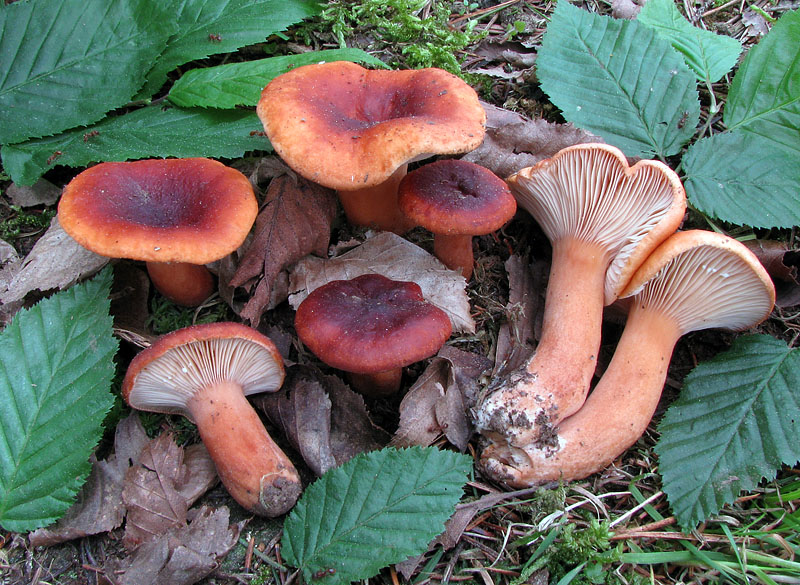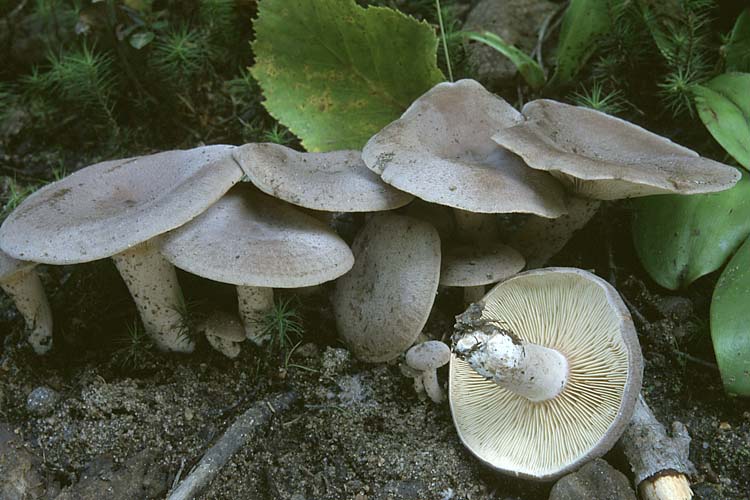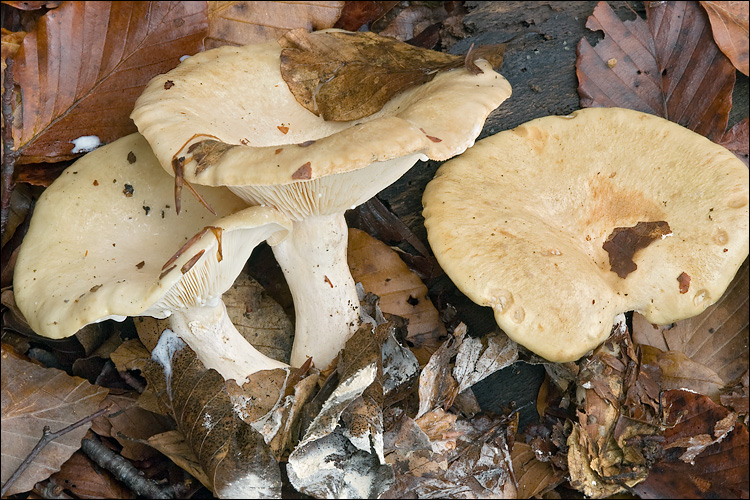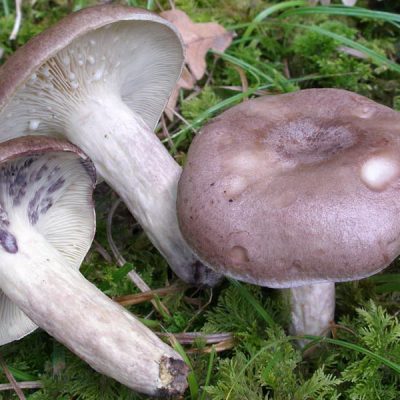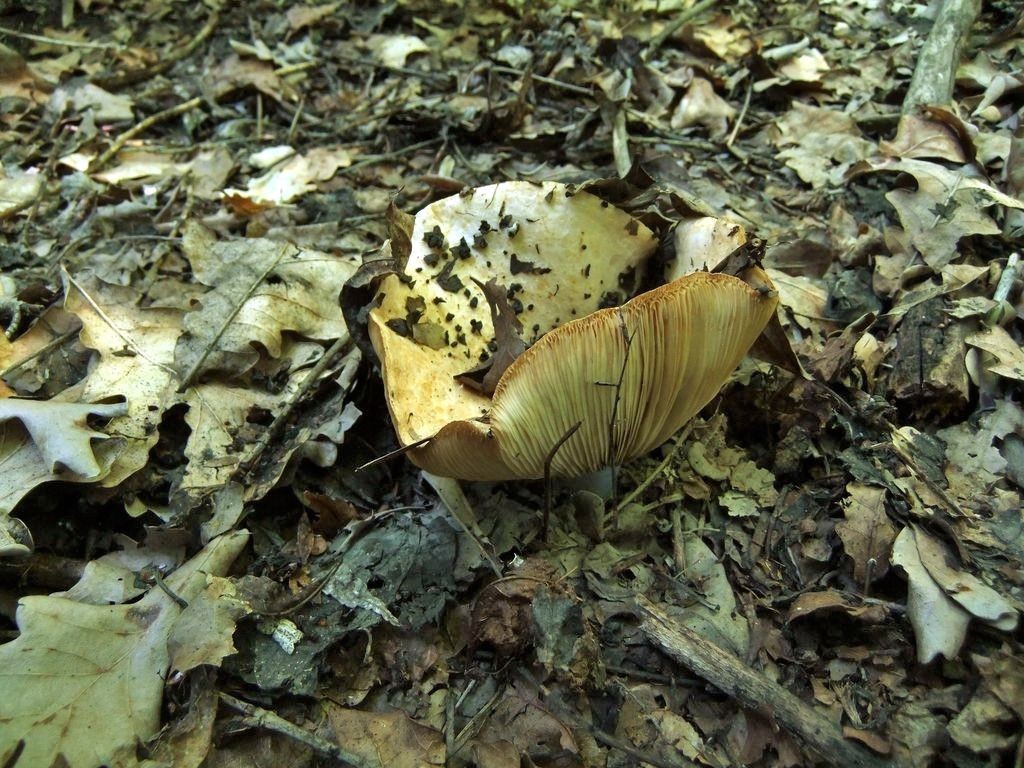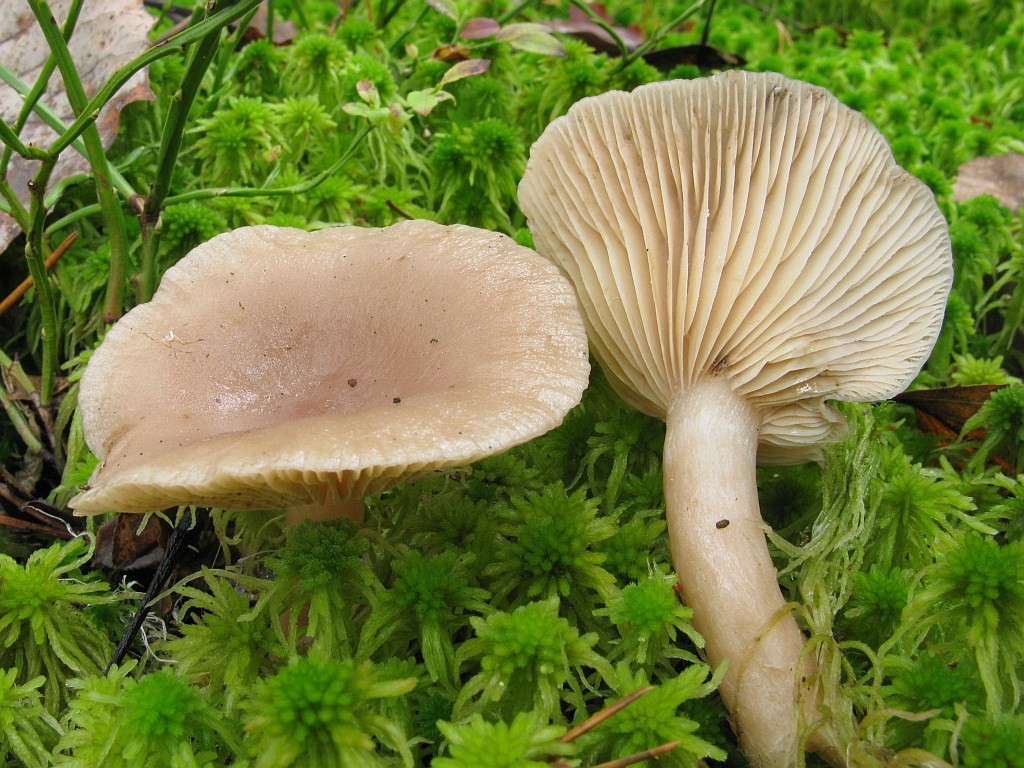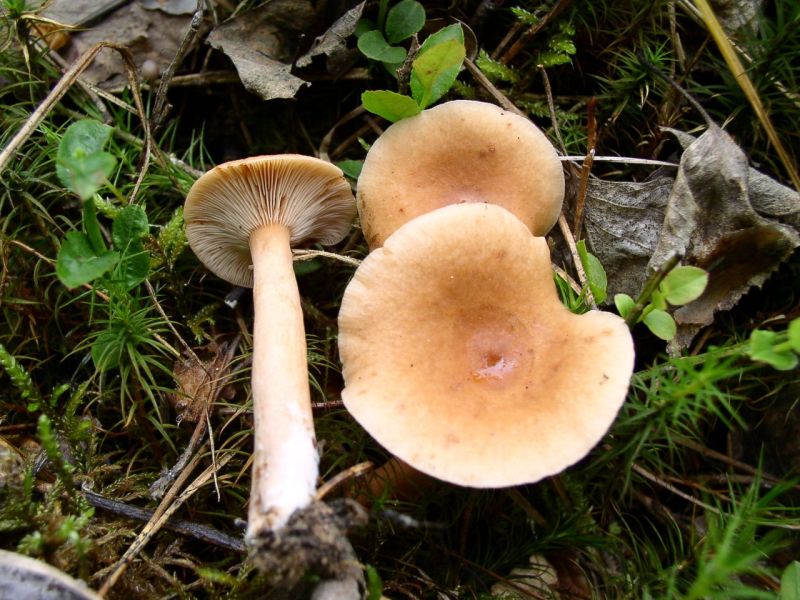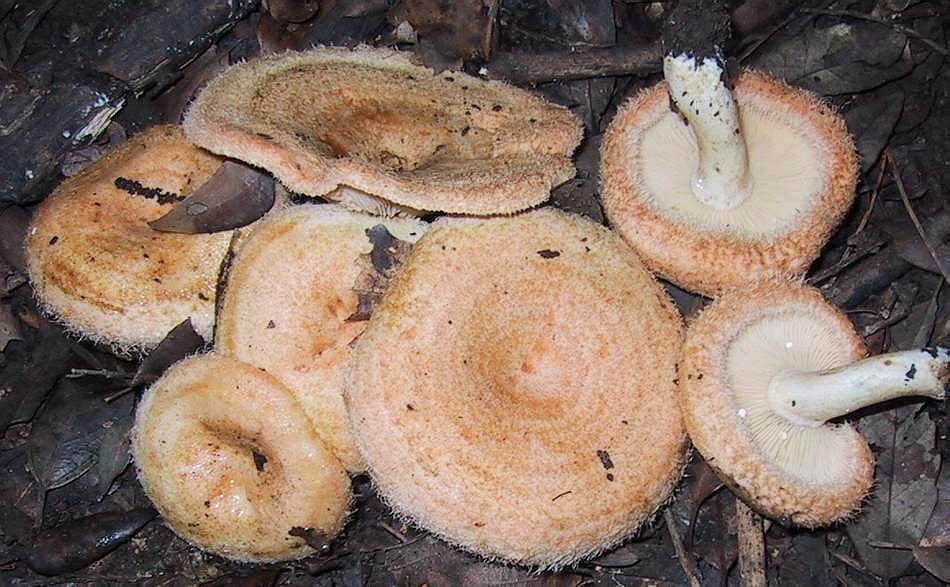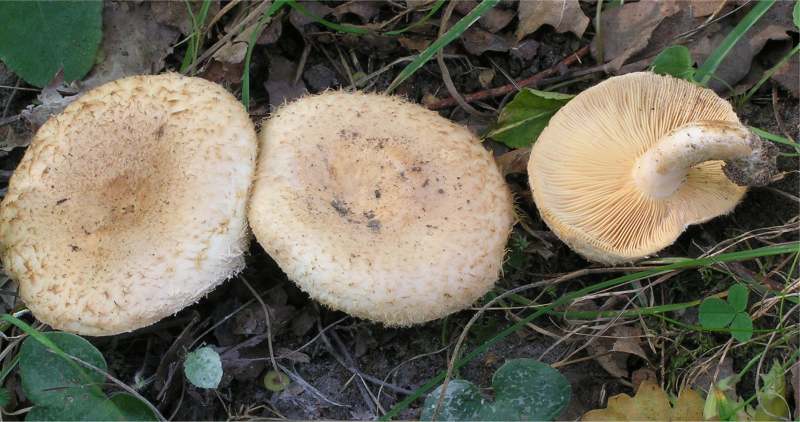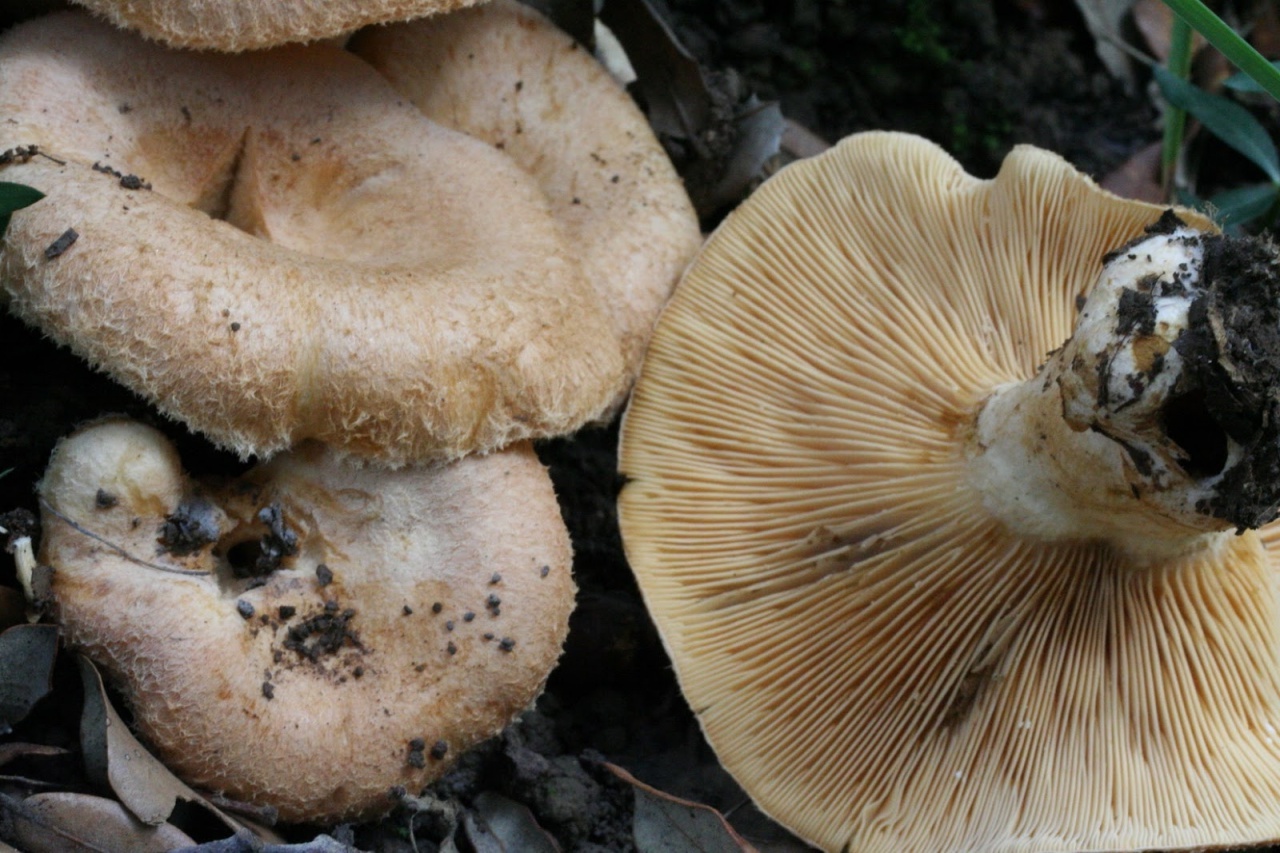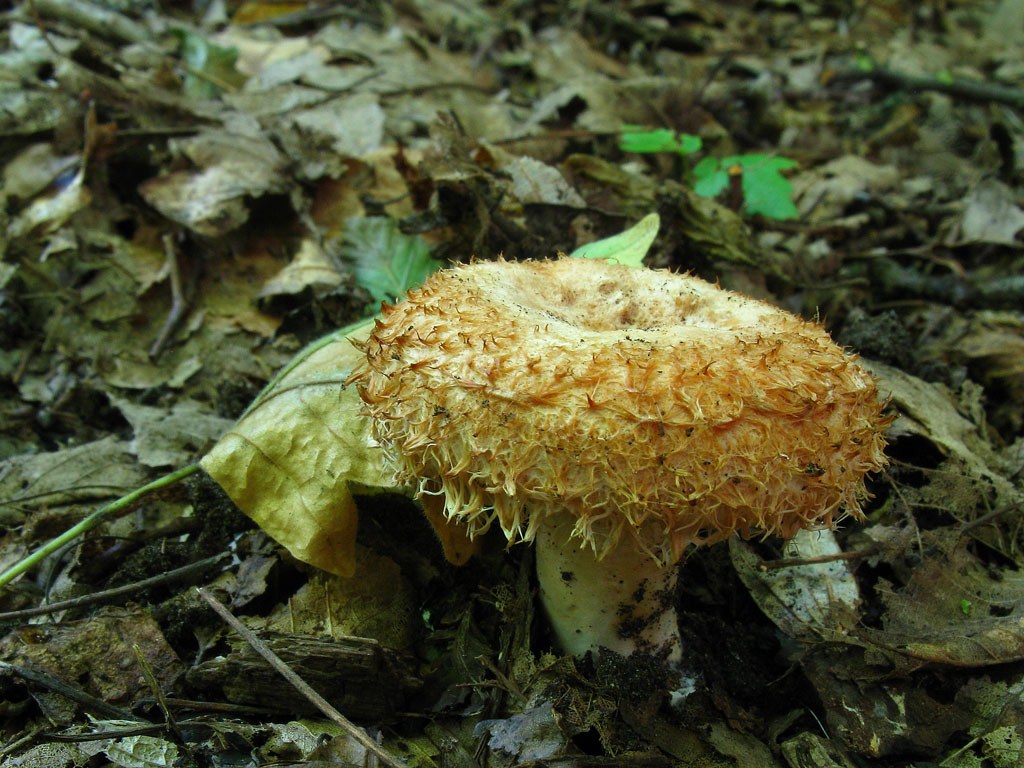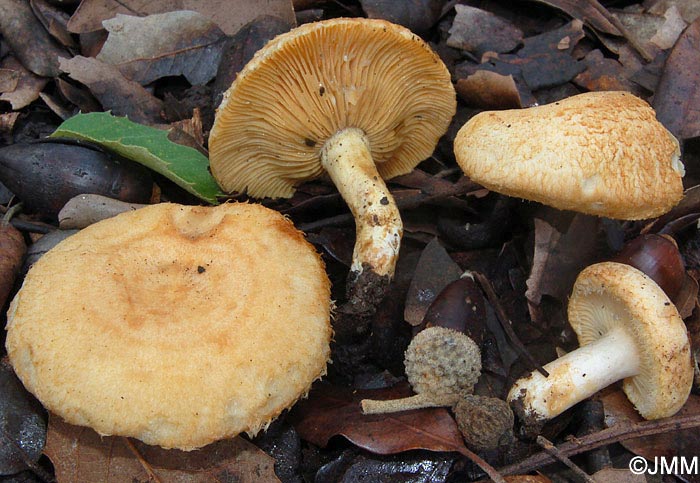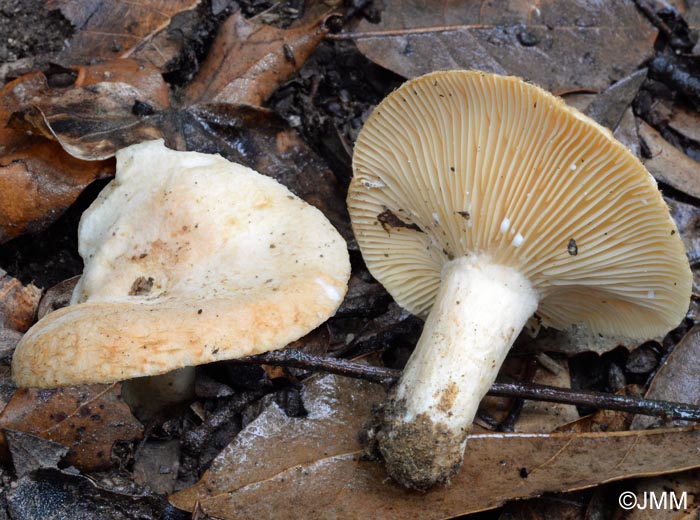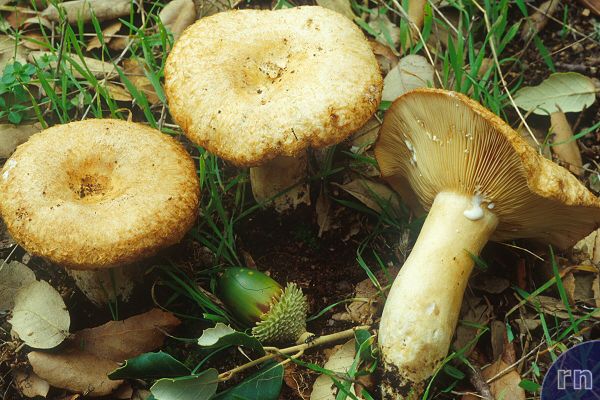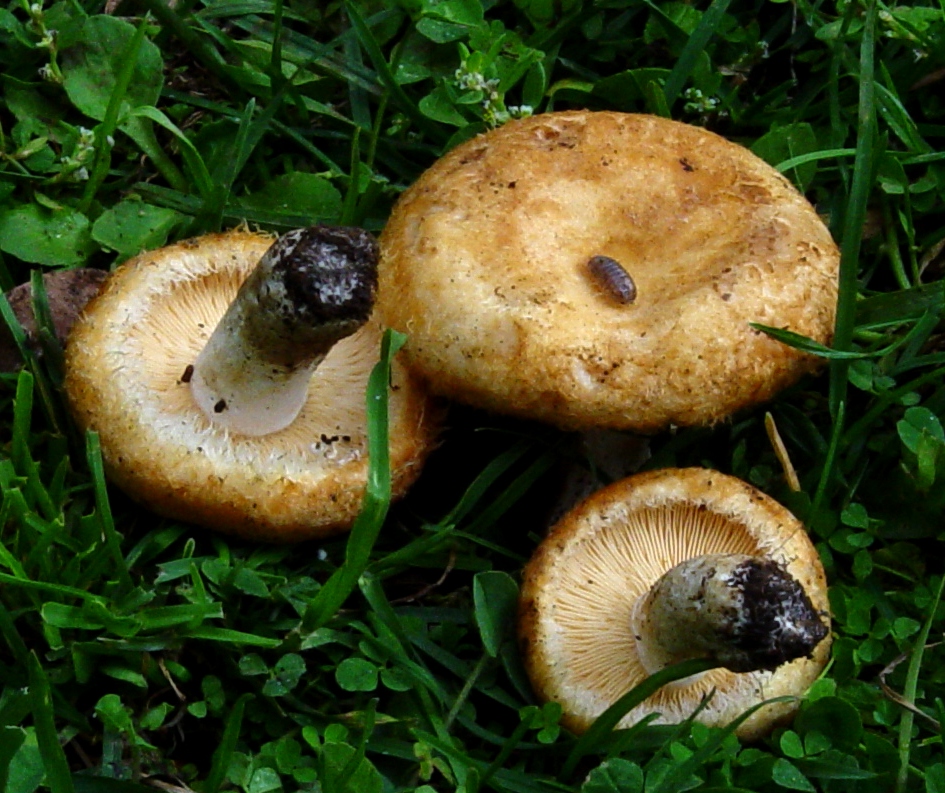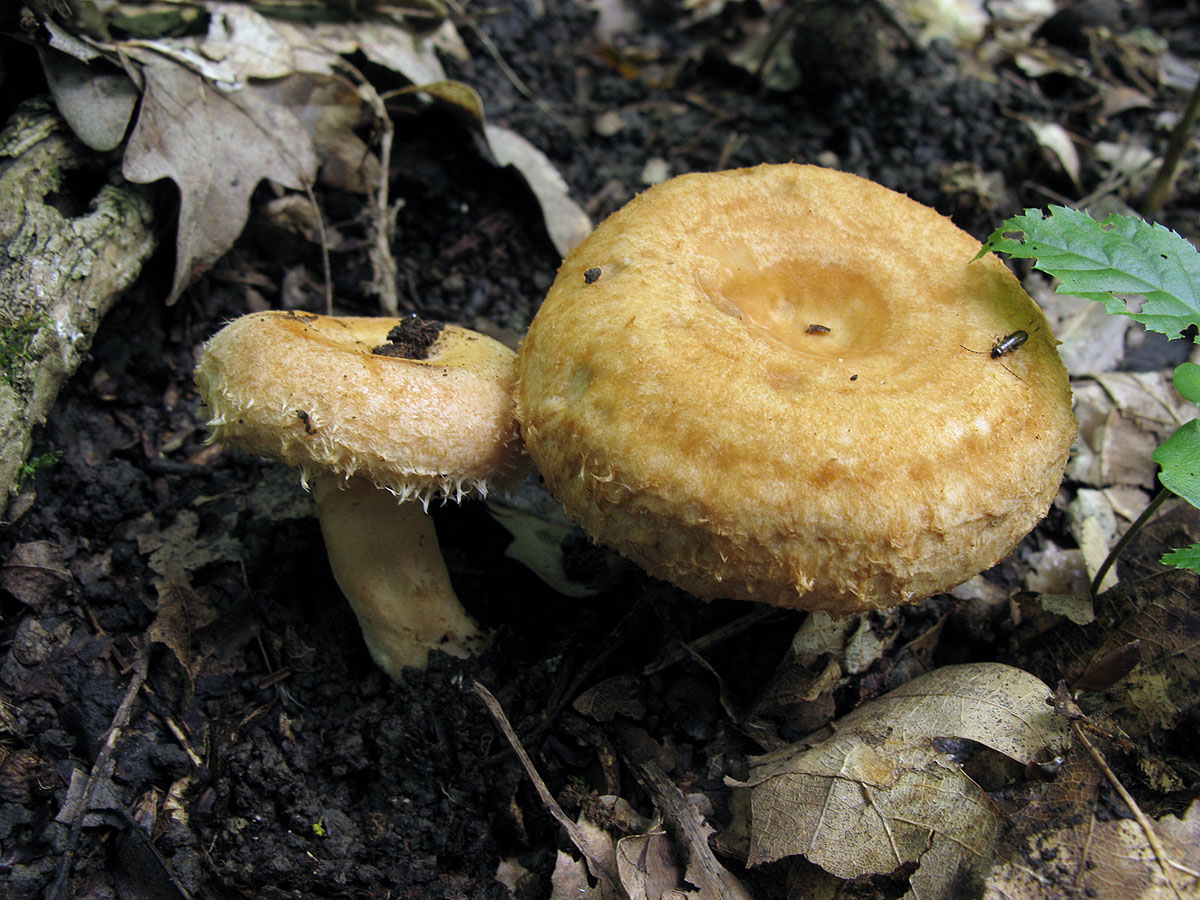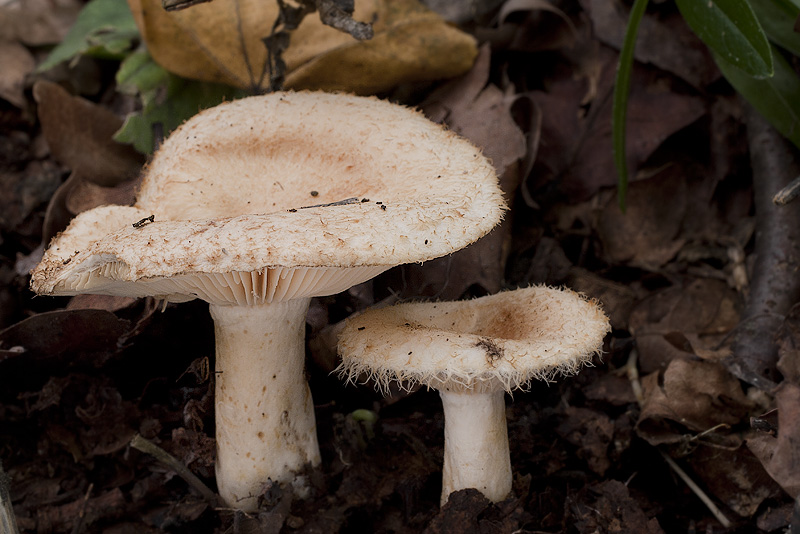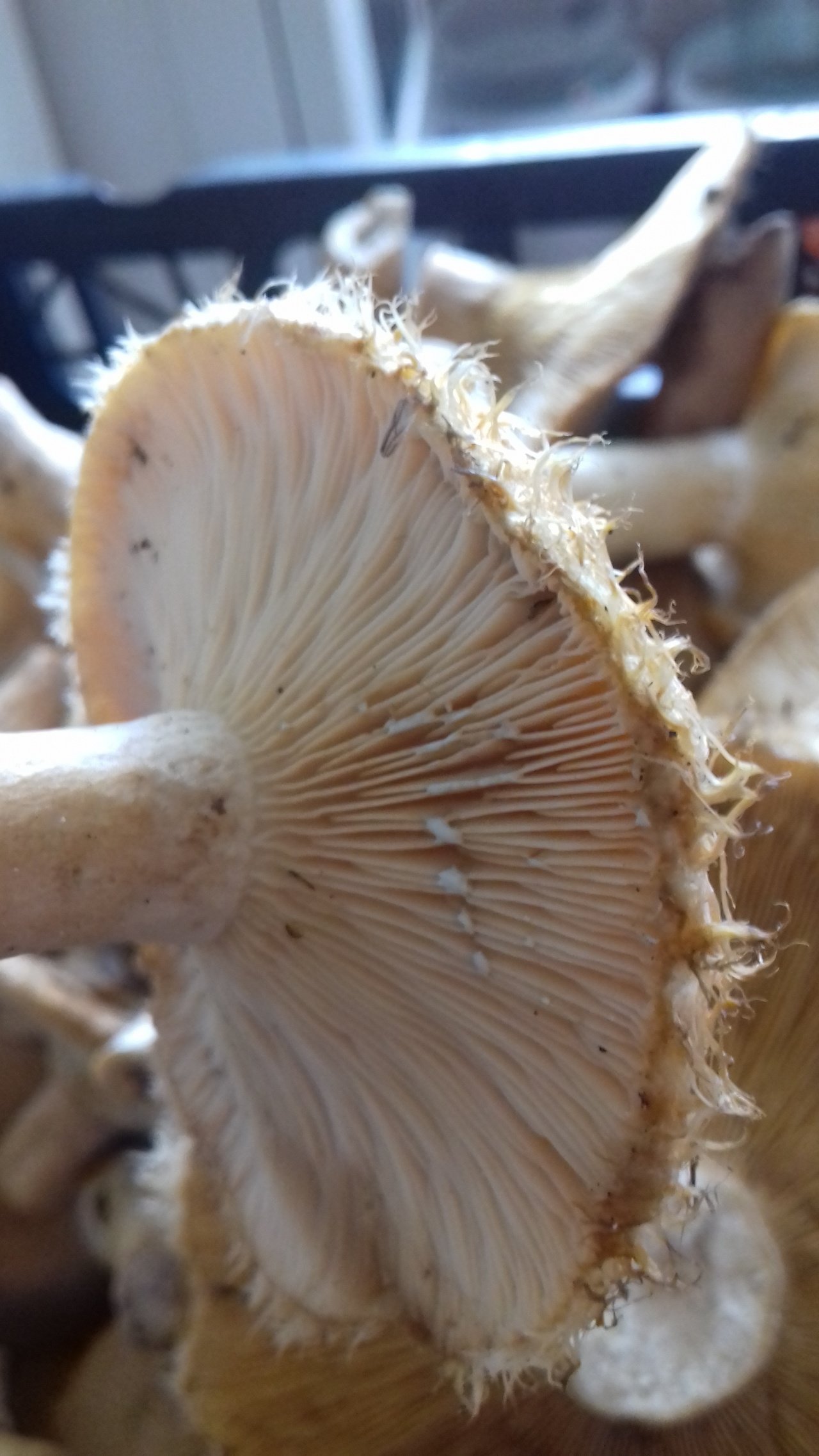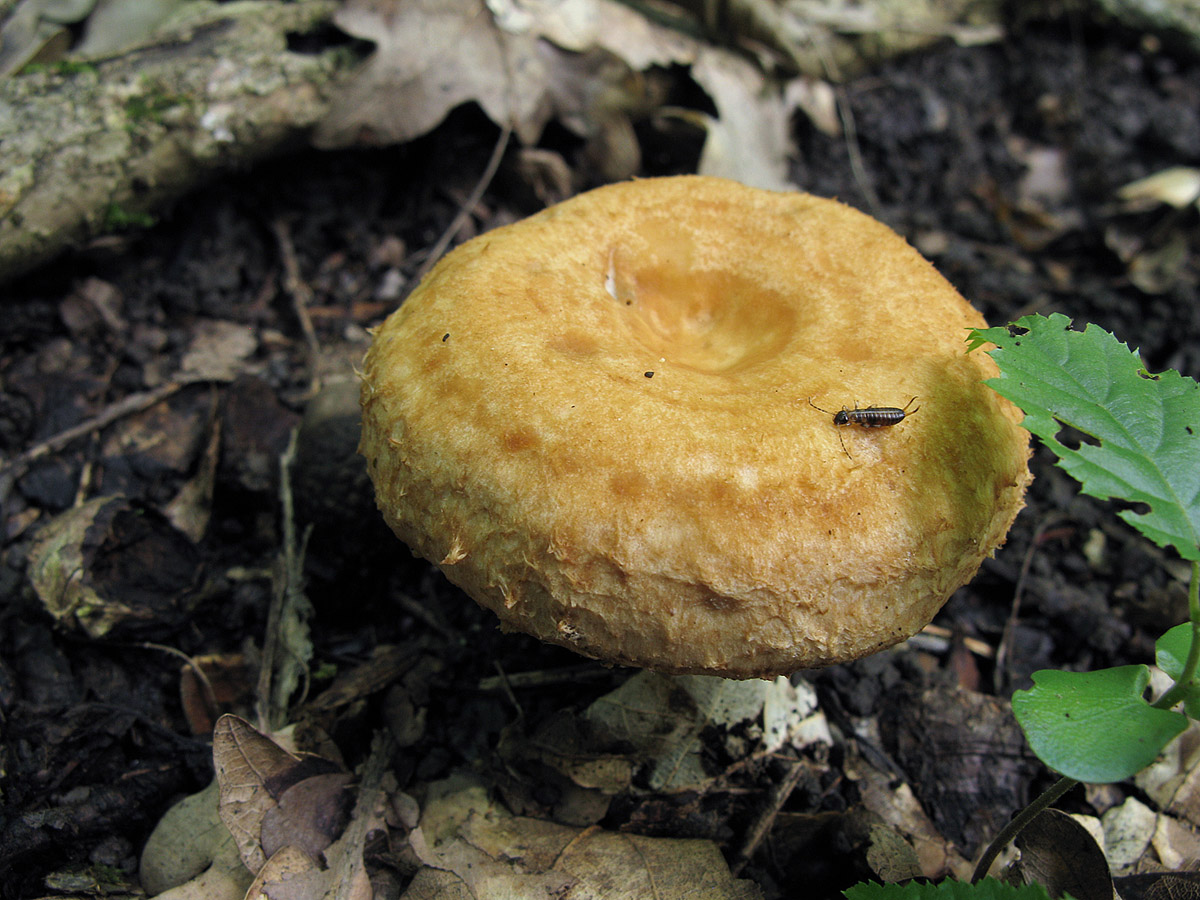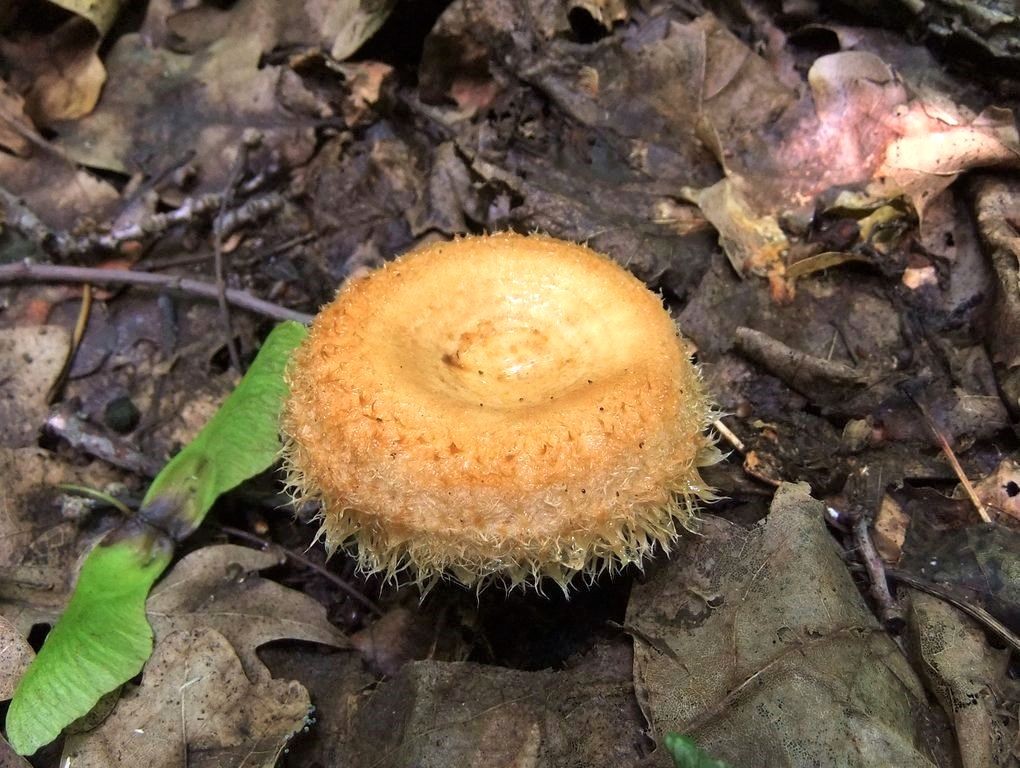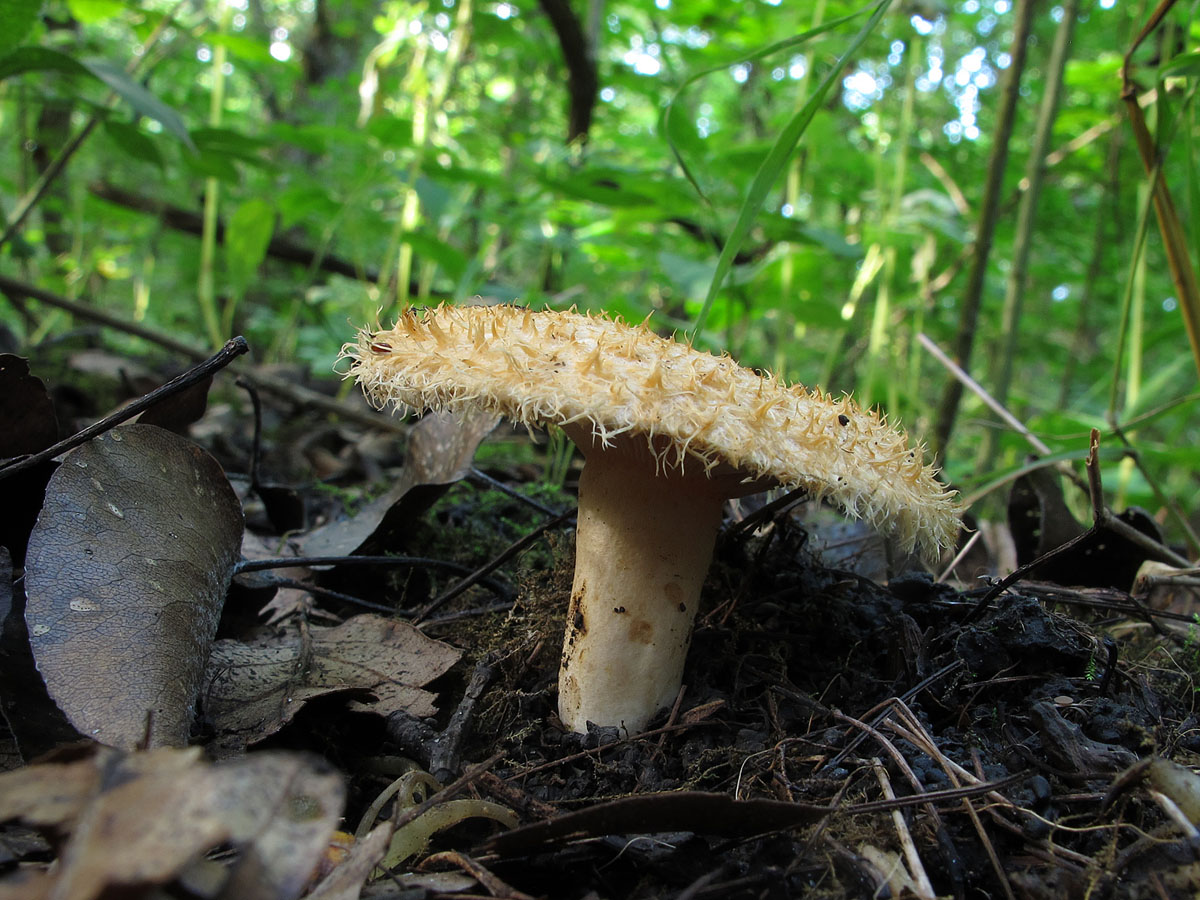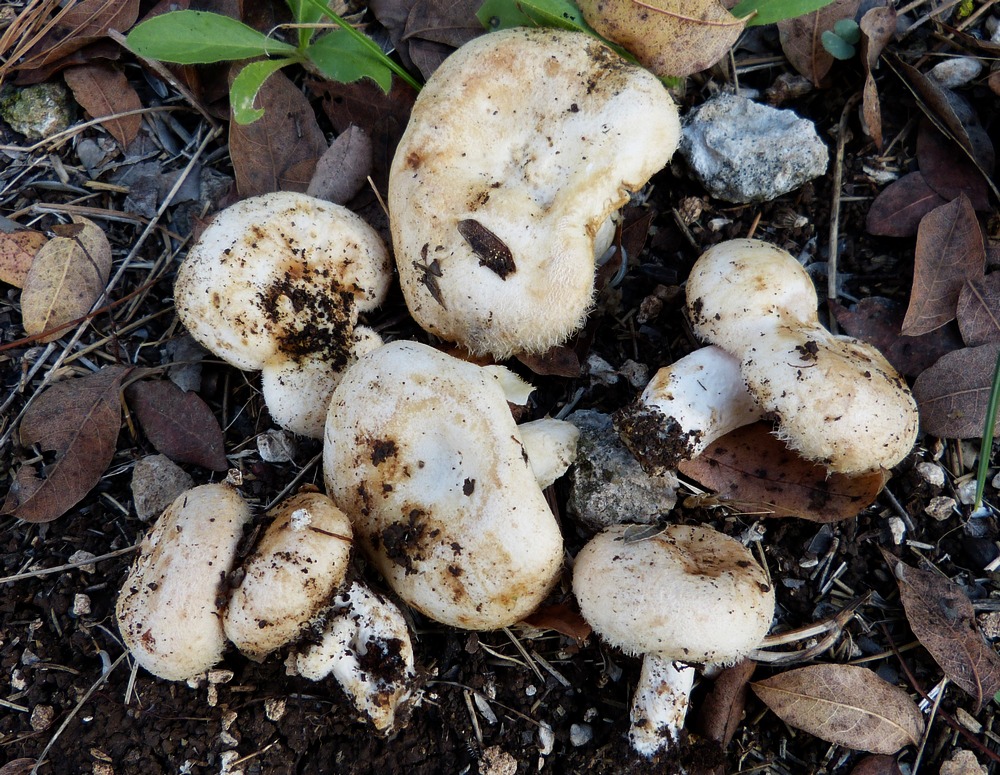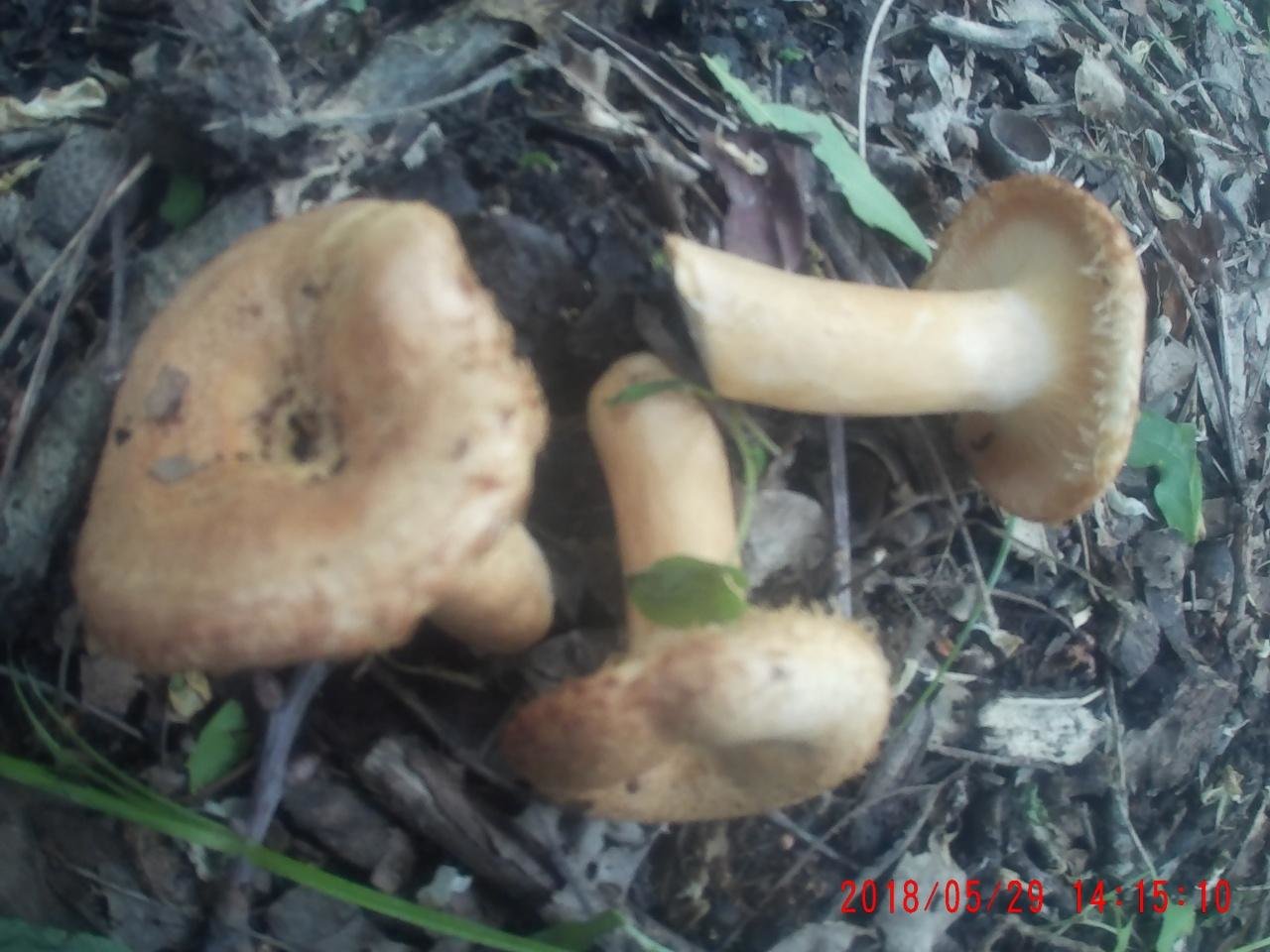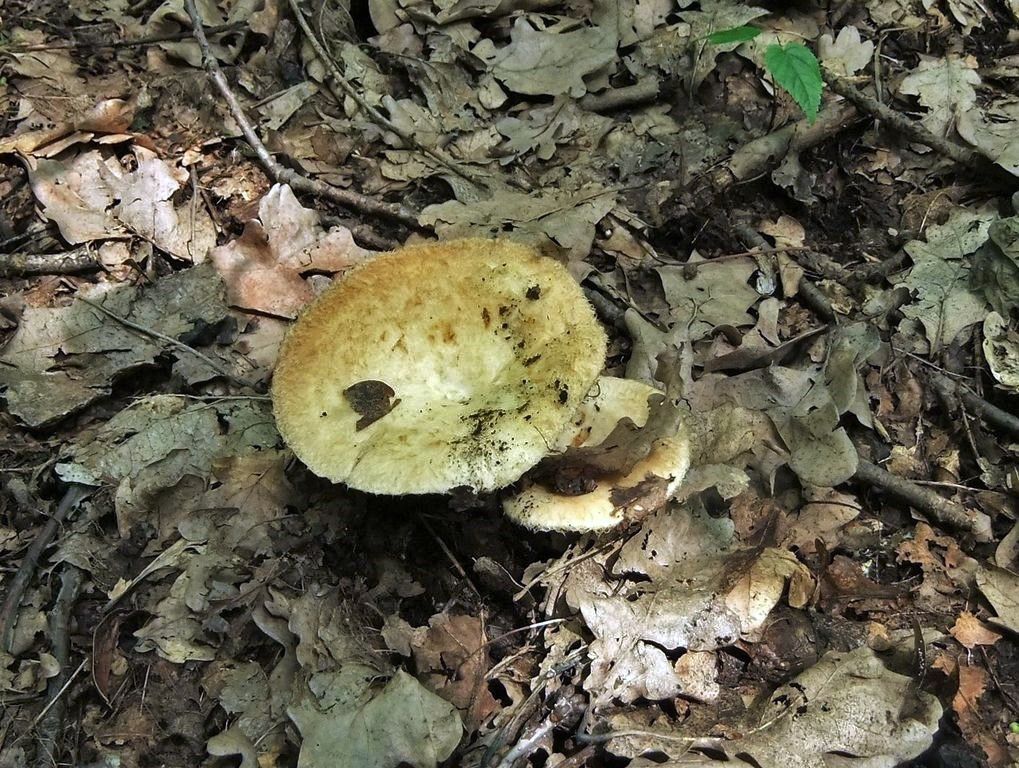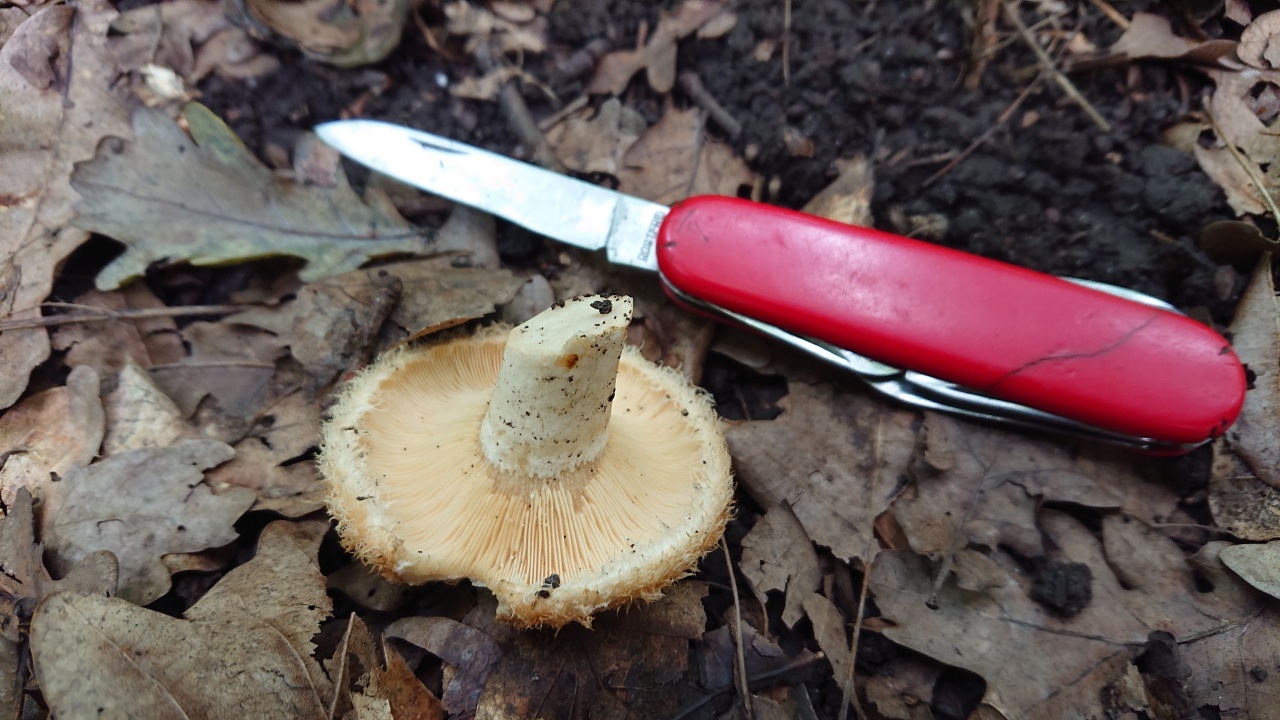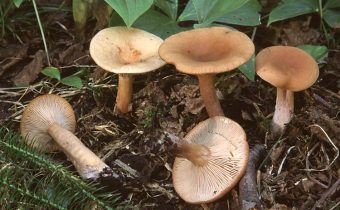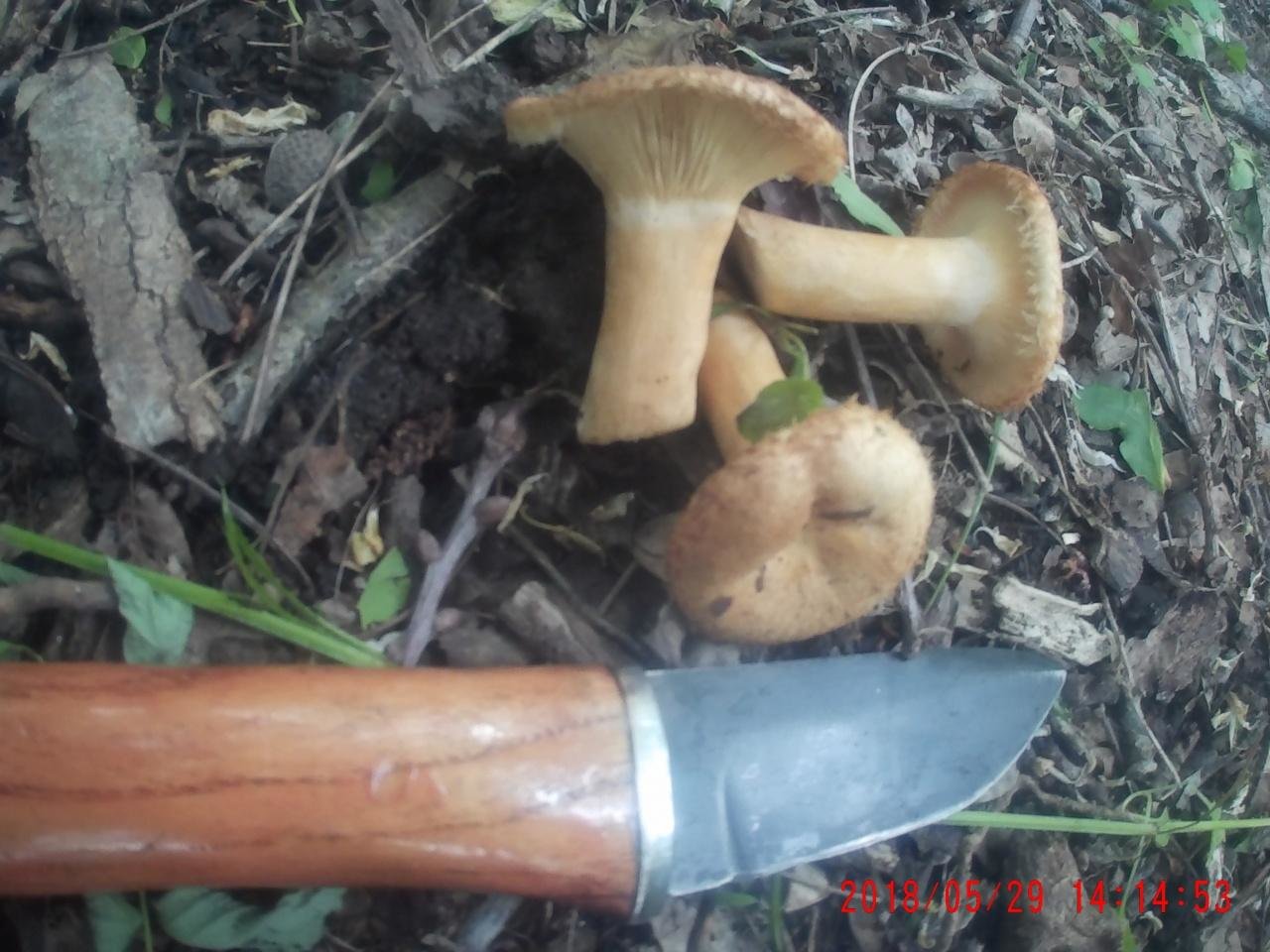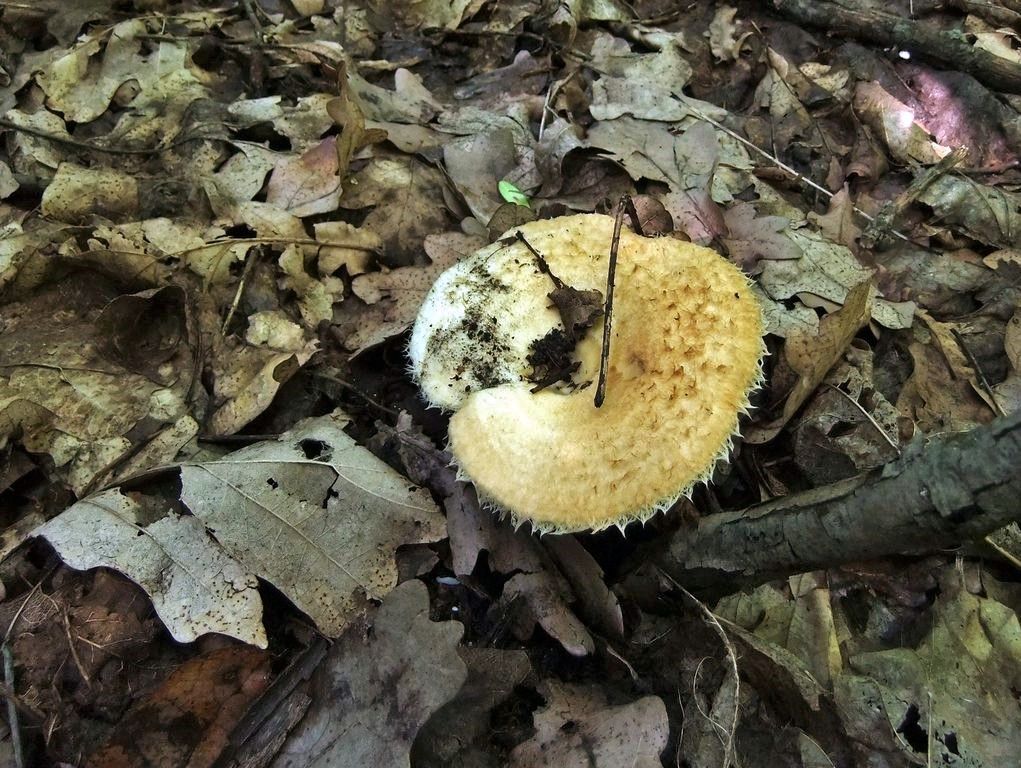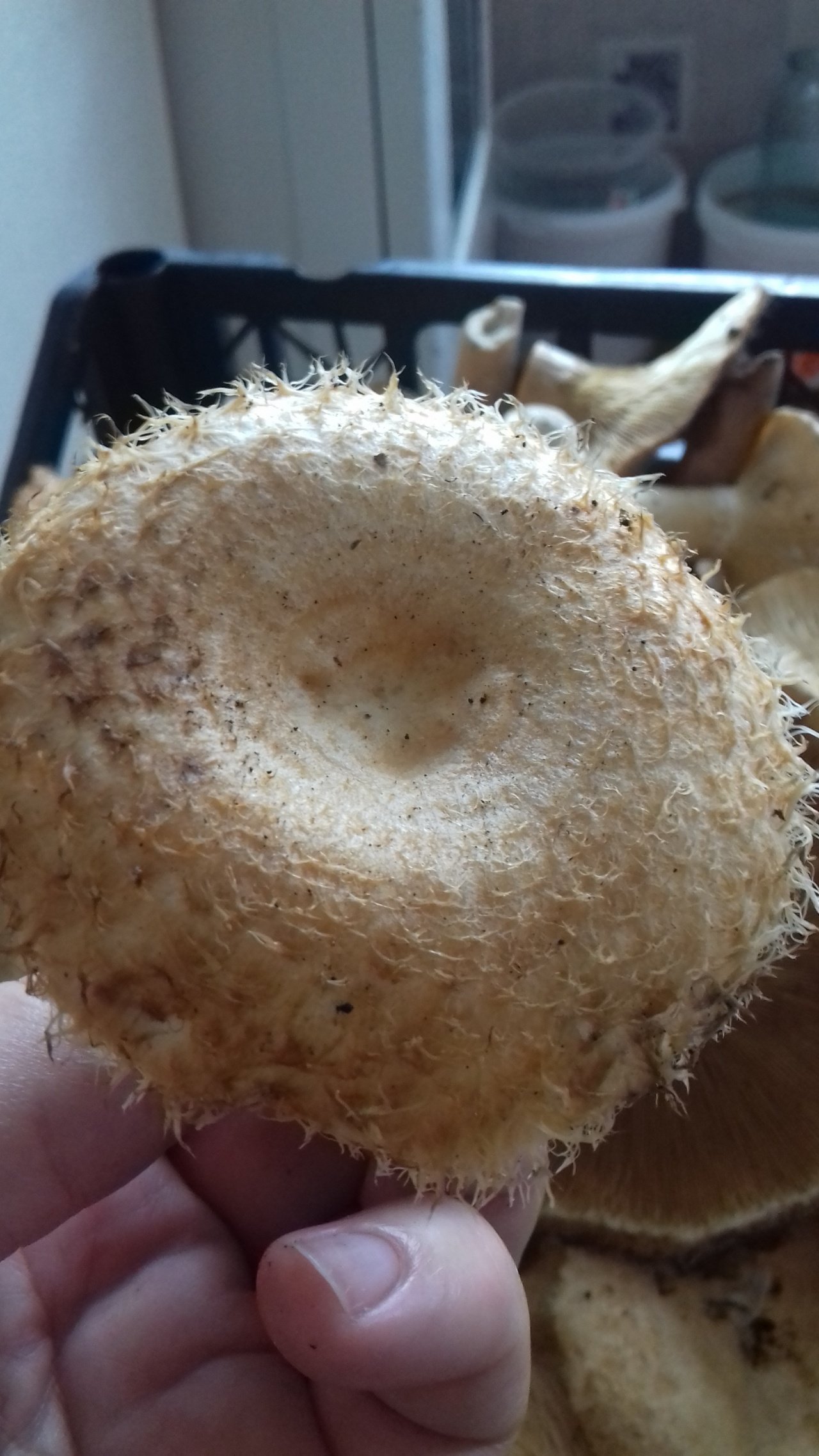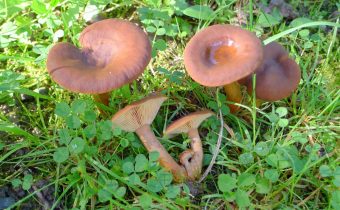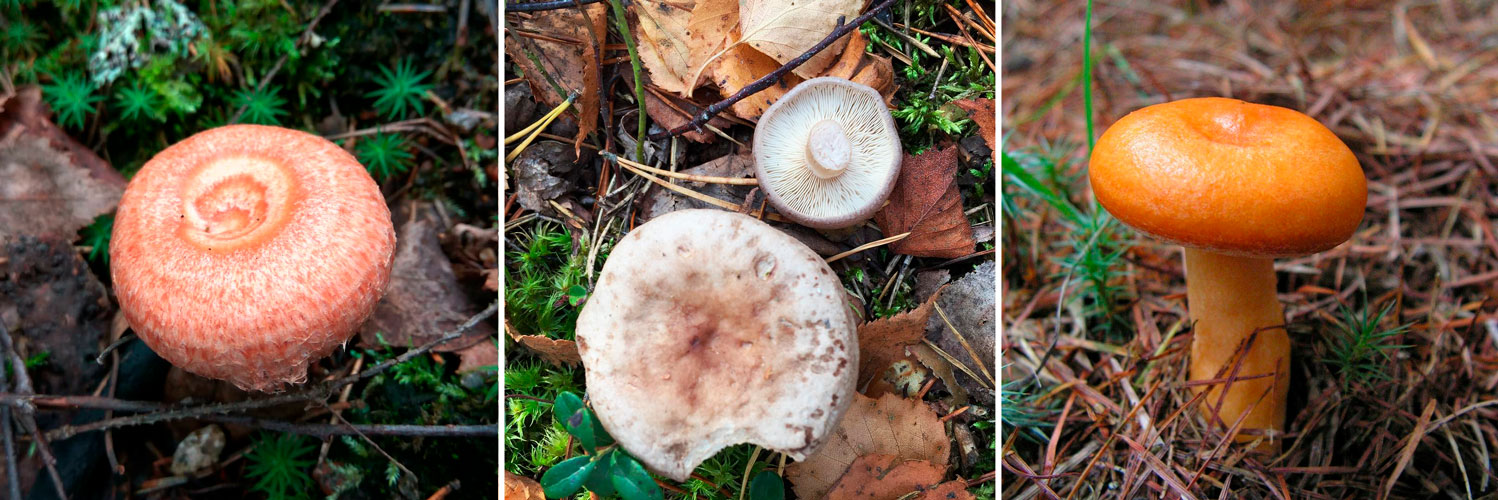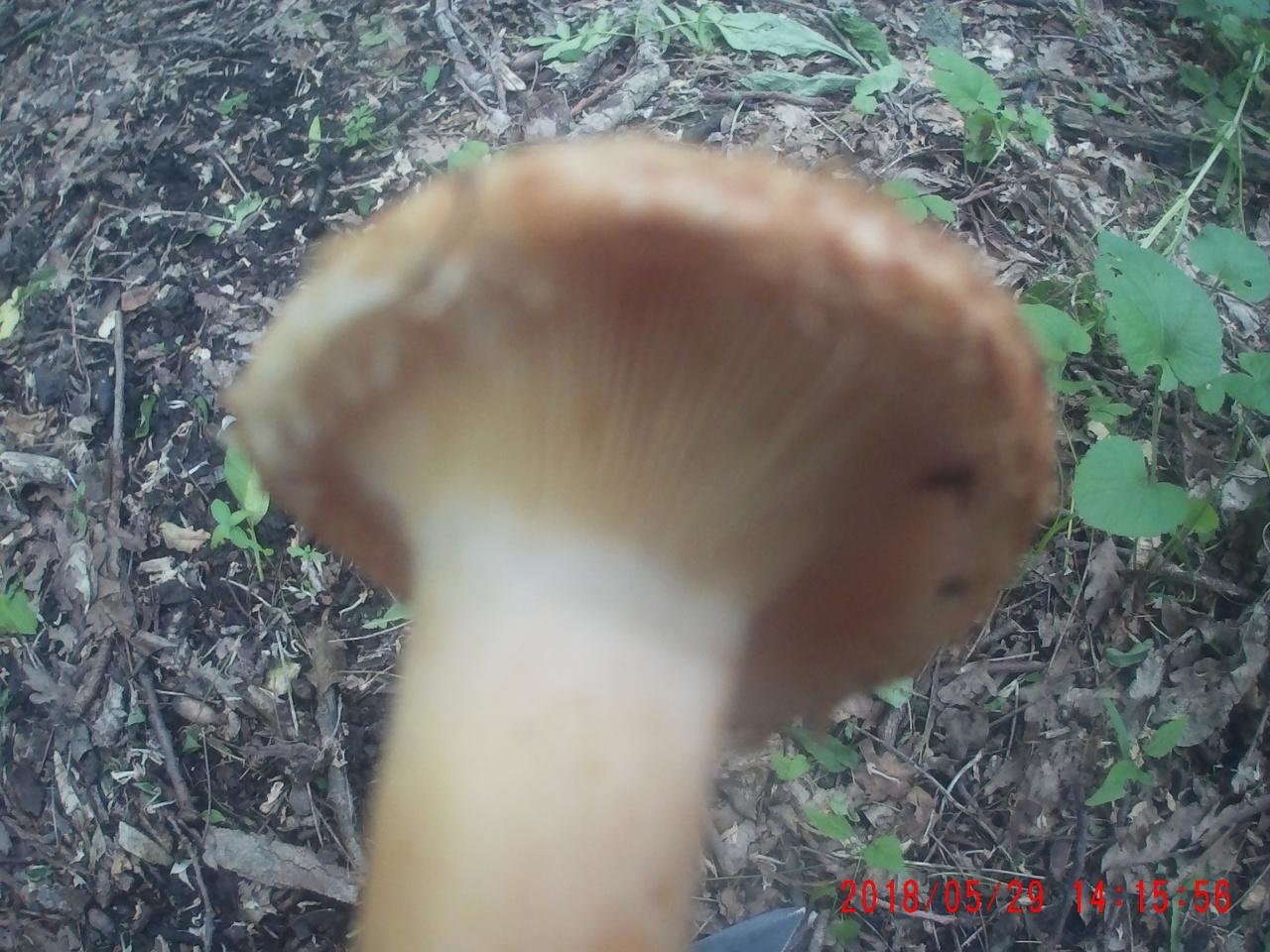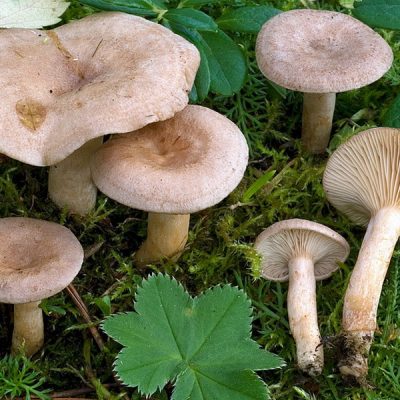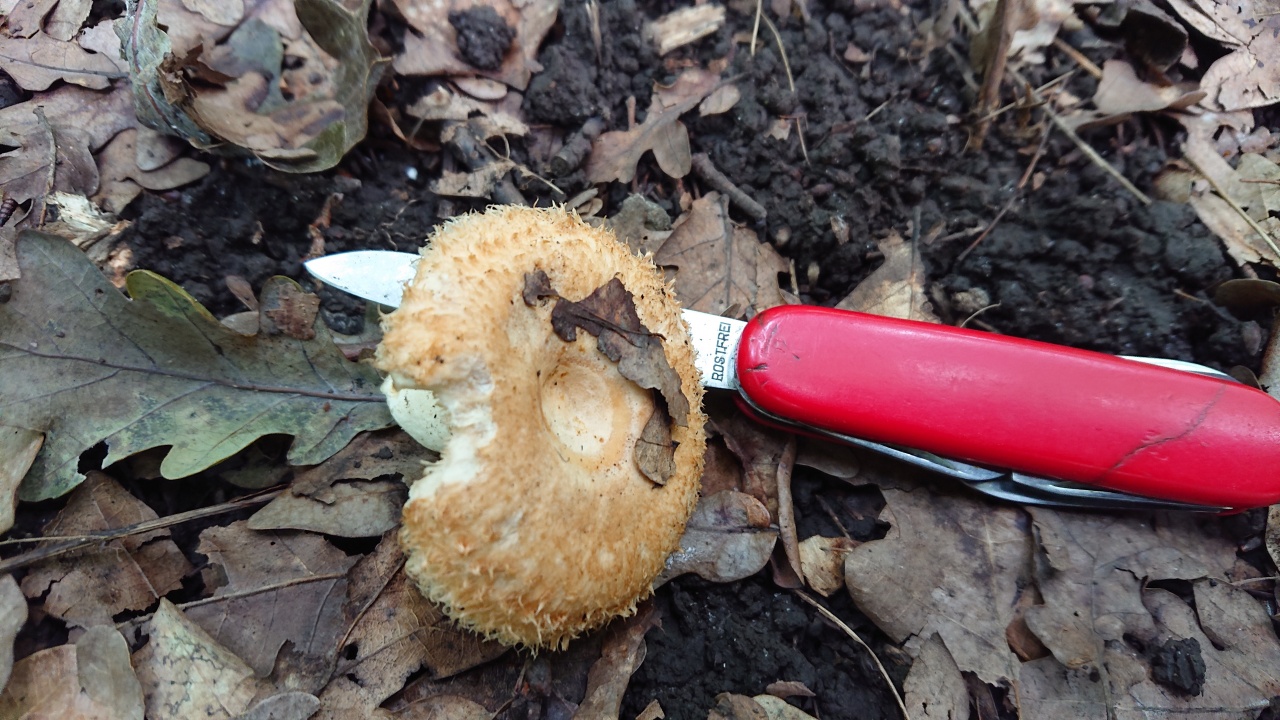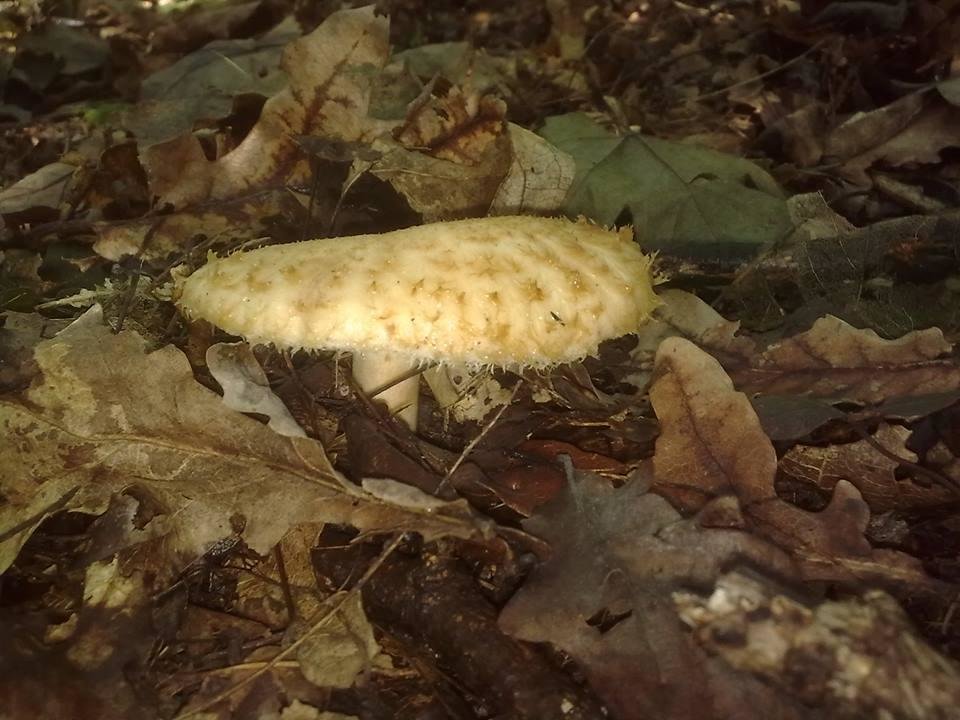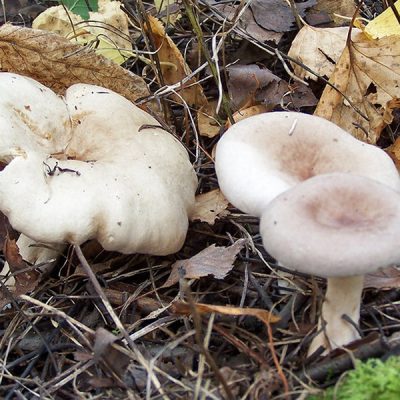Red-brown Milk (Lactarius volemus)
Synonyms:
- Galorrheus volemus
- Lactifluus volemus
- Amanita lactiflua
- Lactarius lactifluus
- Lactifluus oedematopus
- Lactarius oedematopus
- Lactarius ichoratus
- Galorrheus ichoratus
- Lactifluus ichoratus
- Lactarius testaceus
- Millechnik is the best (by the way, the official Russian-language mycological name)
- Podoreshnik (Belarusian - Padareshnik)
Lactarius volemus (Fr.) Fr., Epicr. syst. mycol. (Upsaliae): 344 (1838)
Description
A hat with a diameter of 5-17 (up to 16) cm, convex in youth, then prostrate, possibly pressed in the center, and even up to concave. The edge of the cap is straight, thin, sharp, first tucked up, then straightened and even raised. The color is reddish-brown, brownish-brown, in rare cases, rusty or light buffy. The surface is velvety at first, then smooth and dry. Often cracked, especially in dry conditions. There is no zonal coloration.
Flesh: White, yellowish, very fleshy and firm. The smell is described in various ways, mainly as a herring (trimethylamine) smell that increases with age, but there are more interesting associations, for example with pear flowers, or not at all. The taste is soft, pleasant, sweetish.
The plates are frequent, from adherent to weakly descending, creamy or warm skin shades, often forked at the leg. There are shortened plates (plates).
Milky sap is abundant, white, turning brown and thickening in the air. For this reason, this type of lactarius turns brown and everything else if damaged - pulp, plates.
The leg is 5-8 (up to 10) cm high, (1) 1.5-3 cm in diameter, hard, often full, the color of the cap, but slightly paler, smooth, may be covered with fine pubescence, which looks like frostiness, but not to the touch felt. Often tapered to the bottom.
The spore powder is white. The spores are close to spherical, according to the data 8.5-9 x 8 µm, 9-11 x 8.5-10.5 µm each. The ornamentation is ridged, up to 0.5 µm in height, forming an almost complete network.
Habitat
Occurs from July to October. One of the earliest milkmen. Grows in deciduous, mixed and spruce forests (in general, in all forests). According to the data, it forms mycorrhiza with oak (Quercus L.), common hazel (Corylus avellana L.) and spruce (Picea A. Dietr.).
Similar species
Given the "power" of this mushroom and the abundant brownish sweetish milky juice, perhaps, it has no similar species. The most similar lactic to him, perhaps, is the hygrophoroid lactarius - Lactarius hygrophoroides, but it is easily distinguished by non-brown milky juice and rare plates. Quite conditionally, rubella (Lactarius subdulcis) can be attributed to similar species, but it is thin-fleshed and slender. The same applies to the orange lactarius (Lactarius aurantiacus = L. mitissimus), it is not only small and thin, but also late, does not overlap in terms, although it grows in exactly the same biotopes with spruce.
Edibility
An edible mushroom that can be eaten raw. It is good in raw salted or pickled form, without any heat treatment. I don't like it in another form because of the "wooden" pulp, although, they say, mushroom caviar is good from it. I hunt him specifically and purposefully, for the sake of raw salting.
Literature Used 1) Verbeken, A. & Vesterholt, J. 2008. Lactarius. - In: Knudsen, H. & Vesterholt, J. (eds.): Funga Nordica, 82-107.2) Flora of Belarus. Mushrooms. In 7 volumes. Volume 1. O.S. Gapienko, Ya.A. Shaporova, 2012, Boletales. Amanitales. Russulales.
Video about the miller mushroom:
Miller pink-gray
Habitats of the gray-pink milky (Lactarius helvus):
deciduous and mixed forests, in moss bogs among birches and spruces, in groups or singly.
Season:
July-September.

The cap is large, 7-10 cm in diameter, sometimes up to 15 cm. At first it is convex with curved edges downward, silky-fibrous, with a depression in the middle. There is sometimes a small tubercle in the center. The edges are straightened in maturity. A distinctive feature of the species is a gray-pink, pale-yellow, gray-pink-brown, gray-brown cap and a very strong odor. The surface is dry, velvety, without concentric zones. When dried, mushrooms smell like fresh hay or coumarin.
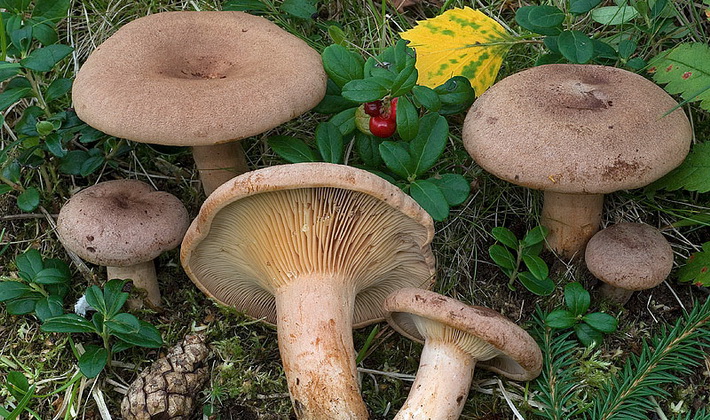
The leg is thick and short, 5-8 cm in height and 1-2.5 cm in thickness, smooth, hollow, gray-pink, lighter than the cap, in youth, whole, strong, lighter in the upper part, mealy, later red-brown.
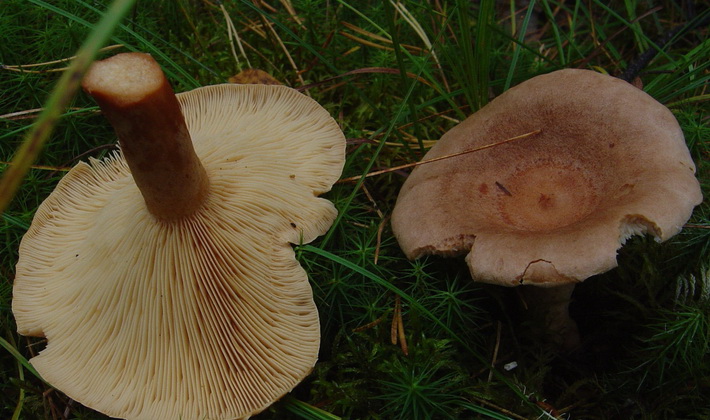
The pulp is thick, brittle, whitish-pale, with a very strong spicy odor and a bitter and intensely pungent taste. Milky sap is watery; older specimens may be completely absent.
Plates of medium frequency, weakly descending to the pedicle, lighter than the cap. Spore powder, yellowish.The color of the plates is yellow-ocher with a pinkish tinge.
Similarity with other species.
By smell:
spicy or fruity, the gray-pink milky can be confused with the oak milky (Lactarius zonarius), which is distinguished by the presence of concentric zones on the brownish cap.
Cooking methods.
Gray-pink millers are considered poisonous in foreign literature. In the domestic literature, they are considered of little value due to their strong odor and conditionally edible after processing.
External description of the mushroom
Mare's Miller (Lactarius mairei) is a classic fruiting body, consisting of a cap and a leg. The fungus is characterized by a lamellar hymenophore, and the plates in it are often located, grow to the stem or descend along it, have a cream color, and are highly branched.
The pulp of the lactician Mayor is characterized by medium density, whitish color, burning aftertaste that appears shortly after eating the mushroom. The milky juice of the mushroom also tastes hot, does not change its color under the influence of air, the aroma of the pulp is similar to that of a fruit.
The cap of the lactarius Mayor is characterized by a curved edge in young mushrooms (it straightens out as the plant reaches maturity), a depressed central part, a smooth and dry surface (although in some mushrooms it may feel like felt). A fluff runs along the edge of the cap, consisting of hairs of small length (up to 5 mm), resembling needles or thorns. The color of the cap varies from light cream to clay-cream, and spherical areas emanate from the central part, painted in a pinkish or saturated clay. Such shades reach about half the diameter of the cap, the size of which is 2.5-12 cm.
The length of the stem of the mushroom is 1.5-4 cm, and the thickness varies within 0.6-1.5 cm. The shape of the stem resembles a cylinder, and to the touch it is smooth, dry, and does not have the slightest dent on the surface. In immature mushrooms, the leg is filled inside, and as it ripens, it becomes empty. It is characterized by pink-cream, cream-yellow or cream color.
Fungal spores are ellipsoidal or spherical, with ridged areas visible. The spore sizes are 5.9-9.0 * 4.8-7.0 microns. The color of the spores is predominantly cream.
Similar species, distinctive features from them
The Miller of the Mer (Lactarius mairei) is very similar in appearance to, however, unlike its pink color, the Miller of the Mer is characterized by a creamy or creamy white hue of the fruiting body. A little pink remains in it - in a small area in the central part of the cap. For the rest, in the lactarius, everything is the same as in the named type of wave: there is hair growth along the edge of the cap (especially in young fruiting bodies), the mushroom is characterized by zoning in coloration. Initially, the taste of the mushroom has a slight pungency, but the aftertaste remains pungent. The difference from the lactarius is that it forms mycorrhiza with oaks, and prefers to grow on soils rich in lime. The pink wave is considered a mycorrhizal with birch.
The mushroom, called the Mayor's milkman, is included in the Red Data Books of several countries, including Austria, Estonia, Denmark, the Netherlands, France, Norway, Switzerland, Germany, and Sweden. The species is not listed in the Red Data Book of Russia; it is not included in the Red Data Books of the constituent entities of the Russian Federation.
The generic name of the mushroom is Lactarius, which means milk-giving. The species designation was given to the mushroom in honor of the famous mycologist from France, Rene Maire.
Millers are faded and brownish
The faded milky is a conditionally edible lamellar mushroom, in some reference books referred to as a marsh wave or a sluggish milky. Grows in small groups or in numerous colonies from the second half of August to the end of September, invariably giving large yields. Yields usually peak in September.Favorite habitats are areas of mixed or deciduous forests covered with a thick layer of moss, as well as wet areas of soil near swamps.
The cap of the mushroom is convex, with curved edges, but gradually it becomes prostrate-depressed, with a slight bulge in the middle and wavy edges. Its diameter is about 8 cm. The surface of the cap is smooth, damp, after rain it is covered with a thin layer of mucus sticky to the touch. It is painted in a grayish or brownish-lilac color, which in dry and hot summers fade almost to white.
Depending on the habitat, a poorly distinguishable pattern from concentric zones may appear on the surface of the cap in mature mushrooms. The plates are frequent, descending to the pedicle, at first cream, and then yellow. The leg is rounded, sometimes slightly flattened, straight or curved, at the base it can be thinner or thicker, hollow inside, about 8 cm high with a diameter rarely exceeding 0.5 cm.Its surface is smooth, moist, of the same color as hat, only slightly lighter. The pulp is thin, brittle, painted in a grayish color, practically odorless, but with a bitter taste. It produces a pungent milky sap, which, on contact with air, changes its white color to olive gray.
The faded milky belongs to the third category of mushrooms. Perfect for pickling, but requires pretreatment that removes bitterness from the pulp.
The brown miller is an edible lamellar mushroom that grows from mid-July to early October. You need to look for it in dense grass, on soils overgrown with moss, as well as at the foot of birch and oak in deciduous, broad-leaved or mixed forests.
The convex cap of young mushrooms eventually becomes at first prostrate, with a slight bulge in the middle, and then funnel-shaped, with a thin wavy edge. Its diameter in mature mushrooms is about 10 cm. The surface of the cap is smooth, dry, velvety, brown or gray-brown, darker in the center. In dry and hot summers, pale spots may appear on the cap or it will completely fade, becoming dirty yellow. Spore-bearing plates are narrow, adherent, white, which gradually changes to yellow.
The stem is rounded, thicker at the base, hollow inside, about 6 cm high and about 1 cm in diameter. Its surface is smooth, dry, of the same color as the cap. The pulp is soft, firm at first, and then loose, cream-colored, which, on contact with air, acquires a pink tint. It produces a white milky juice, pungent, but not bitter in taste, which quickly turns red in the air.
Brownish milky belongs to the second category of mushrooms, has good taste. It can be eaten without preliminary soaking and boiling. In cooking, it is used to prepare all kinds of dishes and for salting.
Useful and medicinal properties of milk mushrooms
Lactarius resimus is also very popular in Russian cuisine. Milk is used by tuberculosis patients. The natural antibiotic is successfully used in pharmaceuticals. It is recommended for diabetics to regulate sugar levels. From the increased calorie content, the milk is hard to digest. The dry matter of the mushroom contains 32% protein. It is a source of vitamin B12.
A large amount of fiber in the composition can cause stomach problems. Improper cooking leads to botulism. Experts note that this is due to improper canning. The fungus is susceptible to radiation
so it cannot be collected near motorways. Mushrooms provide our bodies with good bacteria and are great vegetarian options. The benefit of the mushroom is also expressed in the fact that when it is used, neuroses are reduced.
Collection and storage
Mushroom pickers must comply with several conditions:
- collect only known types of mushrooms;
- use wicker baskets in which the mushrooms are well ventilated and stay fresh longer;
- laid with their hats down, and long-legged ones - sideways.
- twist or swing when assembling, then they are easier to separate.
Fresh mushrooms are perishable. Store them in a cool, ventilated area, or outdoors under a canopy. Usually they are scattered in a thin layer on a specially prepared surface: on tables, clean flooring, tarpaulin. Do not heap them, keep them in barrels, or expose them to direct sunlight or high humidity. The shelf life of lactosers before pre-treatment should not exceed four hours.
Composition and useful properties
The nutritional value of mushrooms depends on many different conditions. For example, young varieties contain much more nutrients, while fresh ones contain almost 90%. The milkman contains such valuable as:, leucine and. They are easily assimilated by the body and do not waste a lot on breakdown. The mushroom contains such a useful substance as lecithin. Their number ranges from 0.1 to 0.9%. They also contain fatty acids:
- palmitic acid;
- stearic acid;
- butyric acid;
- acetic acid.
 Millers, like other members of this genus, contain phosphatides, essential oils and lipoids. In terms of their carbohydrate composition, mushrooms are very close to vegetables, but there are others that are characteristic only of this class: sugar alcohols,. Their content reaches 16%. They are not, but glycogen is present, which in its composition resembles glycogen of animal origin. In the mineral composition, the milkmen are rich, and. Contain such as, and arsenic. They also contain substances such as mycoinulin and parodextrin, which are responsible for the coating of mushrooms during long-term storage, as well as tregazolite and lycosot, which provide their taste and nutritional value.
Millers, like other members of this genus, contain phosphatides, essential oils and lipoids. In terms of their carbohydrate composition, mushrooms are very close to vegetables, but there are others that are characteristic only of this class: sugar alcohols,. Their content reaches 16%. They are not, but glycogen is present, which in its composition resembles glycogen of animal origin. In the mineral composition, the milkmen are rich, and. Contain such as, and arsenic. They also contain substances such as mycoinulin and parodextrin, which are responsible for the coating of mushrooms during long-term storage, as well as tregazolite and lycosot, which provide their taste and nutritional value.
Some of the representatives of this class, due to their beneficial properties and valuable chemical composition, are used in the field of medicine. So, for example, the antibiotic lactarioviolin, which has a negative effect on bacteria - the causative agents of tuberculosis, was identified from the real milk cap and the red camelina in the process of isolating its milky juice. Other types of milkmen have a positive effect on cholelithiasis, acute and purulent conjunctivitis and other visual impairments. And some even contain antibiotics that inhibit the development of pathogenic bacteria, including Staphylococcus aureus.
Appearance
He has a rather fleshy cap, often reaching up to 10 cm in diameter. At a young age, the cap is bent inward at the edges. At first it is convex, but later it becomes prostrate-flat and depressed in the middle. It differs from other milkmen in that the color of the cap has a felt pale-creamy surface, sometimes brownish in color. When wet weather sets for a long time, the cap can acquire a lilac hue. The cap is darker in the center than at the edges.
The hymenophore is lamellar.
The plates are thin, brittle, weakly running along the stem, sometimes adherent to the stem, cream-colored with an ocher tint, often located. When pressed or damaged, they immediately turn gray.
The leg of the mushroom is lighter in color than the cap, it can be cream in color, having a length of up to 7 cm and a thickness of up to 1.5 cm. The leg is hollow, cylindrical in shape, tapering towards the base, flat along its entire length or curved to one side.
The mushroom white pulp is brittle, has a pungent taste and a pleasant mushroom smell.
Milky sap, abundantly protruding at the break, acquires a grayish-greenish color.
Spores are light ocher in color.
a brief description of
Common millechnik, smoothie, spurge, nest box, podolshanka, blue milk mushroom, smoothie ... This mushroom has quite a few names. It belongs to the numerous species of the lactarius, the russula family. The main difference between this seeing mushrooms is the release of a pulp or a spore-bearing layer of juice, similar to. Millers have a specific bitter taste. Like many other representatives of this species, Gladysh is considered a conditionally edible mushroom.Mycologists attributed it to this species, since it requires additional processing before use and has some restrictions in its preparation.
In European cuisine, where they like to use everything in a natural, raw form, common lactic acid is classified as a poisonous mushroom and is forbidden to be eaten. And in our area, conditionally edible mushrooms are subjected to prolonged soaking, salting or repeated boiling, with repeated removal of the decoction. And only then, such mushrooms can be eaten.
Millechnik has a rather wide cap, sometimes reaching up to 18 cm in diameter. Just one of its names - smooth - got it precisely because of the smooth fleshy cap. It becomes slippery when it rains. In young mushrooms, it is more convex, and with age it settles and is pressed in. The color changes from violet-lilac to fawn or even fawn-brown. In older varieties, it fades and becomes pale lilac or yellowish brown with barely visible concentric zones, or none at all. The leg is straight, cylindrical. Has the same color as the hat. Loosens with age and becomes hollow. The lacquer plates are frequent, light; if damaged, they acquire a dark grayish color, mainly due to milky juice. The flesh of the smoothie is dense, strong, white in color with a light creamy shade. The juice emitted from it is white, milky in color. It dries to an olive yellow color. The pulp is very bitter in taste and has a specific smell. Spores are elliptical with ridged or warty ornamentation. Pale, yellowish or creamy spore powder.
How to cook delicious milk mushrooms
Hot salting of real milk mushrooms
- The first step is to select others from the milk mushrooms. Rinse everything several times with water. We erase the dirt with an old toothbrush and carry out surface treatment. Cut the legs and leave to soak for a day. In this case, the water changes during this time 3-4 times. Put the peeled mushrooms in a bucket.
- We transfer the mushrooms to a large container. Now we make a brine: for 1 liter of water, 3 large tablespoons of salt. We mix everything and fill in our mushrooms. We are waiting for everything to boil, after 5 minutes we put everything in a colander. At the same time, we put the brine with which the cans are poured, all in the same proportion. We turn off everything, let the water drain and cool the mushrooms.
- For salting, we use peppers, garlic cloves, dill umbrellas. We take jars of 0.5-0.7 liter, for one jar there are 3 peppercorns and 2 cloves of garlic. We put the seasonings so that there is room for the brine. Cut large mushrooms into 2-3 pieces. Put the mushrooms on the seasoning, and then the words layer of seasonings. We fill everything with brine and leave overnight. Top up in the morning, as the amount of brine will decrease. Close with a plastic lid, everything will be ready in 2-3 months.
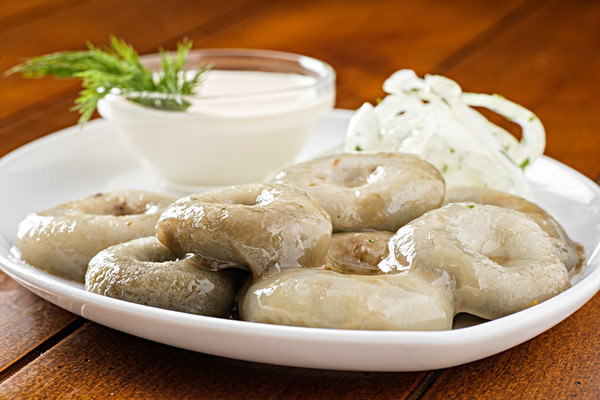
Milk mushrooms are very often harvested for the winter.
Crispy pickled milk mushrooms
- To prepare the brine, we need mustard, garlic, oysterwood and black currant leaves. You need dill, horseradish, salt, sugar and bay leaf. For salting, it is better to choose small lumps. One kg of mushrooms must be boiled to remove the bitterness. After boiling, cook the mixture for 10-15 minutes, do not forget to remove the foam. All the bitterness will go away.
- We send the mushrooms to a colander, they must also be rinsed with boiling water.
- Prepare the brine at the rate of 1 liter: 3 peppercorns, a dill branch, 3 bay leaves, 5 black currant leaves, 5 oyster tree leaves.
- Now we put on fire and wait until it boils, add 2 tbsp. l salt and 2 tbsp. tablespoons of sugar. The brine is boiling.
- At the bottom of the jar we put chopped, 2 cloves of garlic, 1 tsp in the same place. mustard and a pinch of paprika, a sprig of dill. Then we spread the layer of mushrooms by half, then put the horseradish leaves, a branch of dill, 2 cloves of garlic and continue to lay the mushrooms.
- We cover everything with horseradish, dill, 1/3 tsp. mustard and a clove of garlic. Pour the mixture with a boiling solution. We put the banks in a dark place, after a day we place them in the pantry.
Milk mushrooms in batter
Wash the milk mushrooms, clean, beat off and sprinkle with plenty of salt.Then leave for 3-4 hours and cook in batter. Cut the mushrooms into pieces. We will make the batter on mineral water: 2 eggs, 300 g of mineral water and 300 g of flour and a pinch of salt. We mix everything. We will fry with enough oil in a deep frying pan.
The milkweed does not have poisonous spears, all representatives of the Millechniks are conditionally edible. You should read about their differences before walking in the woods.
Edible by the Miller Mayor
Mayor's Millers are edible mushrooms. They can be eaten in any form. They are slightly spicy to taste, and there is also a spicy aftertaste.
The number of the Miller Mayor
Mayor's Millennium is listed in the Red Book of different countries: Estonia, Austria, France, the Netherlands, Norway, Germany, Denmark, Sweden and Switzerland. The Mayor's milkmen are not included in the Red Book of our country.
The similarity of the Mayor's milkmen with other mushrooms
Outwardly, the Mayor's milkman is similar to a pink wave, but the wave, according to the name, is distinguished by a pink tint. The color of the lactarius is mainly cream, and a little pink tint is observed only in the center of the cap.

Other mushrooms of this genus
The faded milky is a conditionally edible member of the family. The diameter of its cap is 3 to 10 centimeters. The cap is thin, but fleshy, brownish or wine-brown in color. The length of the leg reaches 4-8 centimeters, and the diameter is 0.5-1 centimeters. The shape of the leg is cylindrical, in color it is slightly lighter than the cap.
Faded millers are numerous in Eurasia and North America. These mushrooms grow in large groups. You can find them in mixed and deciduous forests, they form mycorrhiza with birches. Fruiting of faded milkers occurs from August to September. They prefer wetlands. Faded millers are eaten mainly in a salty form, while they are soaked for at least 2-3 days.
Orange miller is an inedible mushroom. The diameter of its cap is 3-8 centimeters, and the height of the leg is 3-6 cm. The cap is initially convex, but eventually becomes depressed or funnel-shaped. The hat is covered with a smooth orange skin, which becomes slippery in high humidity. The leg is the same color as the hat or lighter in color.

Orange milky grows in deciduous forests. They live singly or in small groups. They bear fruit actively from summer to autumn. Orange millers form mycorrhiza with deciduous trees. After eating these mushrooms, gastrointestinal disorders often occur, therefore they are classified as inedible species, but no serious poisoning was recorded.
Distribution sites and similar species
Smoothies are widespread in deciduous and coniferous forests of Eurasia. They often form mycorrhiza with trees such as spruce, pine or birch. They love high humidity, so they can often be found in large groups along swamps or on mossy soil, where conditions for growth and reproduction will be the most optimal. The common milky is one of the most common species of the genus of the milky. It grows in temperate latitudes, so it can be found with equal success in the forests of Europe, and in Siberia, and in the Urals, and even in the Far East. The highest fruiting peak occurs at the beginning of August and lasts until the end of October - the time when the greatest amount of precipitation falls. Cool autumn evenings filled with the scent of the freshness of warm rain are a favorite time of their appearance.
Gladysh, or common milky, is a fairly recognizable mushroom, but it is often confused with such representatives of the same species as (Lactarius flexuosus) and meat-red milky (Lactarius hysginus). But if you look closely, you can notice some differences that are not immediately striking. So, for example, the surface of the cap of a gray hat is dry to the touch, the leg is solid, narrowed to the base, and short. It tastes much sharper and sharper. And the meat-red milkman is distinguished by a dark, terracotta color and a corrosive strong aroma.The smoothie also has a similarity with the sluggish lactarius (Lactarius vietus), the juice of which, under the influence of the external environment, turns into gray. And also with the lilac gray lilac (Lactarius uvidus), the juice of which in the air acquires a lilac-purple hue.
Cooking applications
The common miller is a first-class mushroom for pickling and pickling. In the process of such processing, fermentation proceeds quickly in it, due to which the smoothie acquires its characteristic sour taste, which is so appreciated in Russian pickles. The mushroom is quite fleshy, which makes it possible to use it after preliminary boiling for cooking various dishes. Most of the bitterness of the lactarius disappears during heat treatment, so that well-fried mushrooms can also be eaten without subjecting them to cooking. In the finished dish, such smoothies will have a piquant spicy, slightly bitter aftertaste, like seasoned mushrooms. Northern peoples have long revered this mushroom and often use it for culinary purposes. After all, their natural bitter taste scares away pests, therefore, lactic acid plants are less susceptible to damage by insect larvae and worms than other fungi. And in Finland, for a long time, there has been its own original recipe for making smoothies baked on a fire or grilled.
Salting common lactarius
Immediately before salting, the mushrooms should be soaked in water for several days. The water present at the same time must be changed periodically. This is done in order to etch out the bitterness. After that, the milkmen blanch for about 10 minutes.
The correct course of the primary processing process is important, since its violation can lead to unnecessary consequences in the form of a loss of taste of the mushroom or intestinal upset. Cold and hot methods are used for salting the common lactarius.
Hot is characterized by preliminary boiling of mushrooms after primary processing. The cold method omits this process.
Korean mushrooms
 To prepare the dish you will need:
To prepare the dish you will need:
- smoothies or other bitter mushrooms;
- soy sauce;
- sugar;
- vinegar;
- ground coriander;
- garlic;
- hot red pepper;
- sesame;
- cilantro.
Boil the mushrooms several times before draining the processed water. It is advisable to leave a slight bitter aftertaste for piquancy. Season the prepared milkmen with soy sauce, add and sprinkle with vinegar. Mix all this and taste the marinade to correct the taste. Sprinkle generously with spices. pre-fry in vegetable oil and pour the resulting mixture into the mushrooms. Add fresh green cilantro, mix everything and cool. After that, Korean-style mushrooms are ready and can be served. Ordinary, not bitter mushrooms are not suitable for such a recipe, since having their own delicate taste they will simply be lost in spices and the dish will not give the desired taste and effect.
Lilac Miller
Habitats of the lilac lilac (Lactarius lilacinum):
broadleaf with oak and alder, deciduous and mixed forests, grow singly and in groups.
Season:
July - early October.
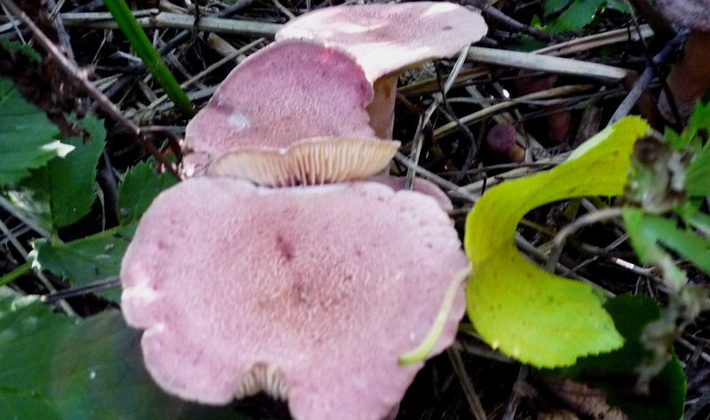
The hat has a diameter of 4-8 cm, first convex, later convex-outstretched with a concave middle. A distinctive feature of the species is the lilac-pink color of the cap with a brighter center and lighter edges. The cap may have subtle concentric zones.

Leg 3-8 cm high, 7-15 mm thick, cylindrical, sometimes curved at the base, dense at first, later hollow. The color of the stem varies from whitish to yellow-cream.
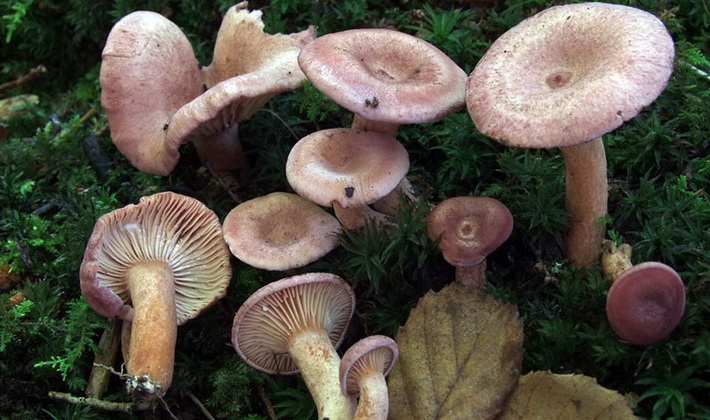
The pulp is thin, whitish-pinkish or lilac-pink, not spicy, slightly pungent, odorless. Milky juice is abundant, white, in the air it becomes lilac-greenish.
The plates are frequent, straight, thin, narrow, adherent and slightly descending along the stem, at first cream, later lilac-cream with a lilac shade.
Variability:
the cap color can range from pinkish brown to reddish cream, and the stem can range from creamy brown to brown.
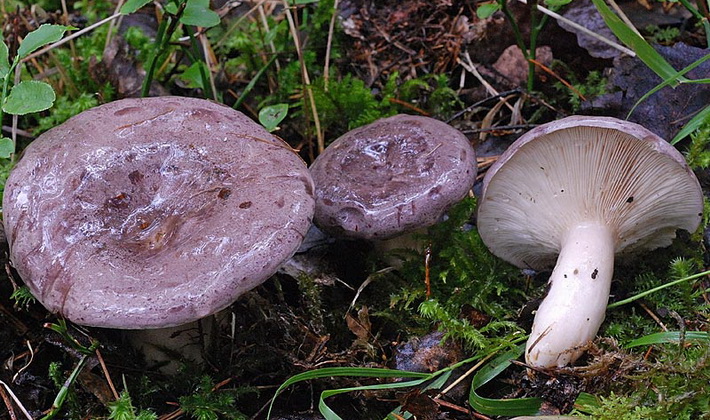
Similarity with other species.
The miller is lilac in color similar to smooth, or common lactarius (Lactarius trivialis)
, which is characterized by rounded edges and pronounced concentric zones with a purple and brown tint.
Cooking methods:
salting or pickling after pretreatment.
conclusions
The common miller, or smooth, is a mushroom that only true mushroom pickers or gourmets can appreciate. But if prepared correctly, using the preliminary primary processing of the product, he can make himself fall in love with an ordinary consumer. It turns out to be divine in a salted form, but for this it requires a long and laborious preparation process. These mushrooms bear fruit for a rather long time, then when other mushrooms are already leaving, therefore, in fact, they have no competitors. And due to their high yield, they often appear on the tables of hospitable hosts and even on store shelves.
Some of the representatives of the milky species have found widespread use in modern medicine. From their milky juice, valuable antibiotics are obtained, which help in the treatment of such unsafe diseases as tuberculosis and staphylococcus aureus. Also, their beneficial properties allow you to fight purulent eye infections and are effective in gallstone disease.
It is important to remember how to properly collect and store these mushrooms so as not to put yourself at risk of poisoning or cause an eating disorder. And also do not forget that in European countries this mushroom belongs to poisonous, and only thanks to careful primary processing, it is allowed to use it in our regions.
Mushrooms of the genus Mlechnik belong to the Syroezhkov family. Their edibility category is low (3-4), however, despite this, milkmen were traditionally revered in Russia. Collect them now, especially those varieties that are suitable for pickling and pickling. In the mycological classification, there are about 120 species of Lactarius, about 90 of them grow on the territory of Russia.
The first among the milk-keepers in June are the milky ones that are not caustic and pale yellow. All lactarius are edible mushrooms and can be distinguished by the presence of juice at cut sites or breakages. However, they become edible, just like milk mushrooms, after preliminary soaking in order to eliminate bitterness. They grow in groups.
The September milkmen occupy large areas in comparison with the August ones, getting closer and closer to swampy places, rivers and canals.
Millers and milk mushrooms in October strongly change color after the first frost. This change is so strong that it can be difficult to distinguish between them. Only those milkmen who have not changed their appearance and properties under the influence of frost can be used for food, soaked and salted.
You can find photos and descriptions of the most common types of milky mushrooms on this page.
Habitats of the non-caustic milky (Lactarius mitissimus):
mixed and coniferous forests. They form mycorrhiza with birch, less often with oak and spruce, grow in moss and on litter, singly and in groups.
Season:
July-October.

The hat has a diameter of 2-6 cm, thin, at first convex, later spread out, becomes depressed by old age. There is often a characteristic tubercle in the center of the cap. The central area is darker. A distinctive feature of the species is the bright color of the cap: apricot or orange. The hat is dry, velvety, without concentric zones. The edges of the cap are lighter.
As you can see in the photo, the leg of this milky mushroom is 3-8 cm high, 0.6-1.2 cm thick, cylindrical, dense, then hollow, of the same color with the cap, lighter in the upper part:

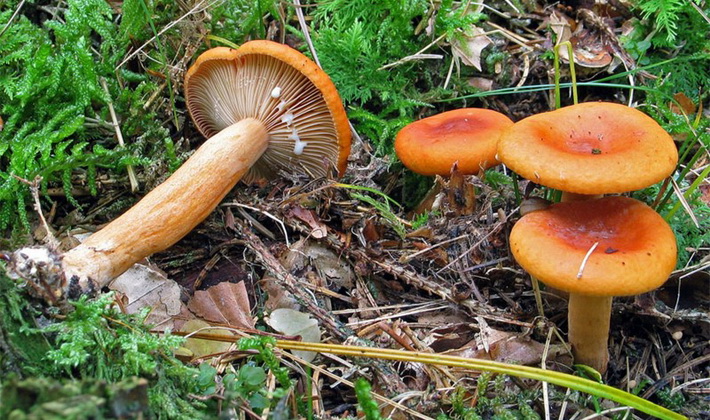
The flesh of the cap is yellowish or orange-yellowish, dense, brittle, with a neutral odor. Under the skin, the flesh is pale yellow or pale orange, without a special smell. Milky juice is white, watery, does not change color in air, not pungent, but slightly bitter.
Plates, adherent or descending, thin, medium frequency, slightly lighter than the cap, pale orange, sometimes with reddish spots, slightly descending to the pedicle. The spores are creamy ocher in color.
Variability.
The yellowish plates become bright buffy over time. The cap color ranges from apricot to yellowish orange.

Similarity with other species. The non-caustic milky is similar to brownish milky (Lactatius fuliginosus)
, in which the color of the cap and leg is lighter and a brownish-brownish color is preferable, and the leg is shorter.
Cooking methods:

